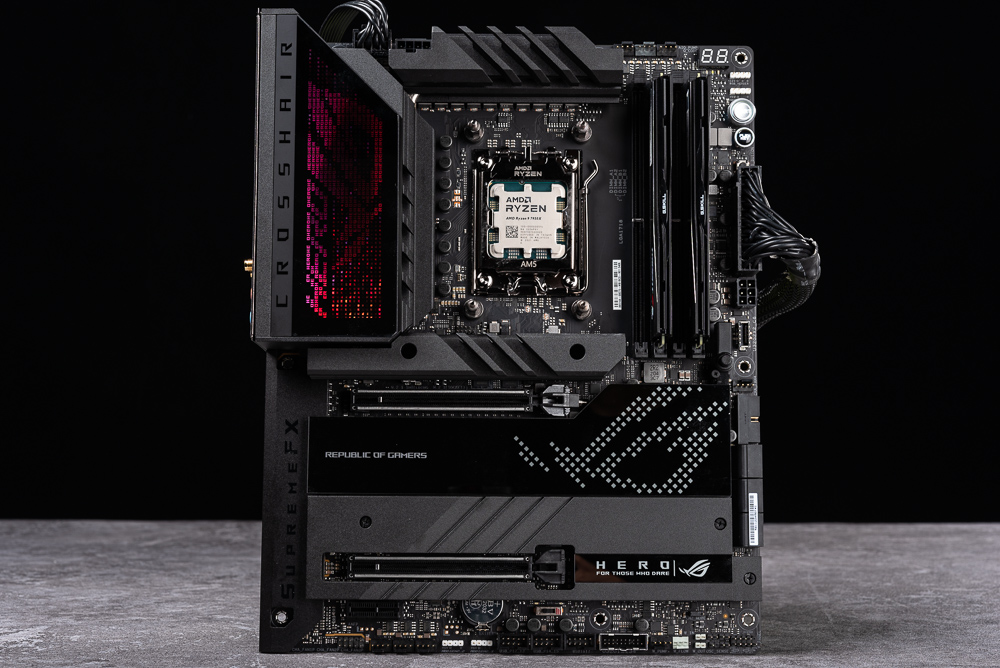
This generation of ROG CROSSHAIR X670E motherboard officially introduces AI overclocking function, providing AI overclocking mechanism to predict CPU SP, and radiator rating, and also arrange DDR5, PCIe 5.0 graphics cards, and up to 3 PCIe 5.0 SSDs, totaling 5 M.2 Expansion capability, with front USB-C 20Gbps support 60W fast charging, 2 USB4 Type C, 2.5GbE LAN, Wi-Fi 6E and other specifications are fully loaded, and the specifications are fully loaded without needing to cut channels, this generation X670E hero I when.
Specifications
Dimensions: ATX (30.5cm x 24.4cm)
Processor Support: AMD Ryzen 7000
Processor Pin: AMD AM5
CPU Power Phase: 18+2 Phase 110A Power Stage
Chipset: AMD X670
BIOS: 256Mb ROM, UEFI AMI
Memory : 4 x DIMM, MAX 128GB, DDR5 6400+(OC)/5600 MHz, EXPO / XMP
Display Output: HDMI, 2 x USB4 Type C DP
Expansion Slots: 2 x PCIe 5.0 x16 (x16, x8/x8)
storage ports : 6 x SATA 6Gb/s, M.2_1 PCIe 5.0 x4, M.2_2 PCIe 5.0 x4, M.2_3 PCIe 4.0 x4, M.2_4 PCIe 4.0 x4, PCIe 5.0 M.2 interface card (PCIe 5.0 x4)
Network: Intel I225V 2.5GbE LAN, ASUS LANGuard
Wireless: Intel 802.11ax Wi-Fi 6E 2×2, BT 5.2
Audio: ROG SupremeFX 7.1 ALC4082, ESS SABRE9218PQ DAC/AMP
USB Ports: 2 x USB 3.2 Gen 2×2 Type C ( 1 front expansion), 2 x USB4 Type C, 9 x USB 3.2 Gen 2 (8A/9C), 4 x USB 3.2 Gen1 (expansion required), 6 x USB 2.0 (expansion required)
RGB: 3 x ARGB 4-1pin, 1 x RGB 4pin
FAN: 1 x 4-pin CPU, 1 x 4-pin CPU OPT, 1 x 4-pin AIO PUMP, 4 x 4-pin Chassis, 1 x W_PUMP+, 1 x 2-pin Water In, 1 x 2-pin Water Out, 1 x 3-pin Water Flow
(Front USB 3.2 Gen 2×2 Type C supports 60W PD/QC4+)
ROG CROSSHAIR X670E HERO out of the box / I have everything you want Extreme has
AMD Ryzen 7000 brings an upgraded version of Zen 4 architecture and 5nm process, more crazy full-core 5GHz, up to 5.7GHz Boost clock, and the X670E platform with new AM5 pins brings a comprehensive upgrade. Not only does it use a dual-chip serial connection, but the number of I/Os is twice that of the previous generation X570, which also allows ROG CROSSHAIR X670E HERO to bring a comprehensive upgrade.
ROG CROSSHAIR X670E HERO maintains the design elements of this ROG generation: Polymo lighting effect, blackening, mirror and dot matrix ROG logo, etc. The specifications are fully upgraded, with 18+2 phases of 110A Power Stage power supply per phase to meet the performance required by the 7950X, 4 DIMM DDR5 memory slots, support for 128GB capacity, and overclocking memory such as EXPO, AEMP, and DOCP.
On the other hand, after the Ryzen 7000 integrates the RDNA 2 graphics core for the first time, the motherboard can provide 1 HDMI and 2 USB4 Type C (DP) internal display video outputs, allowing players to boot normally during installation testing or without installing a discrete graphics card. ; And 2 USB4 ports, which use Intel JHL8540 Thunderbolt 4 controller chip, so it is compatible with peripheral devices such as Thunderbolt.
In terms of expansion, the motherboard provides two PCIe 5.0 x16 slots to support single-card x16 and dual-card x8/x8 channel splitting. The storage surface is basically 6 SATA, and up to 5 M.2 expansions (including PCIe 5.0 M.2 Card). The M.2_1 and M.2_2 slots on the motherboard use the PCIe 5.0 x4 channels provided by the CPU. The M.2_3 and M.2_4 use the PCIe 4.0 x4 lanes of the chipset.
For network and sound, the basic configuration is Intel I225V 2.5GbE LAN and Intel 802.11ax Wi-Fi 6E 2×2 / BT 5.2 wireless network, ROG SupremeFX 7.1 ALC4082 sound chip, and ESS SABRE9218PQ DAC/AMP. And a total of 23 USB ports, including USB 3.2 Gen 2×2 Type C supporting 60W fast charging and 2 USB4 Type C, providing USB 20Gbps and USB4 (Thunderbolt) 40Gbps external transmission function.
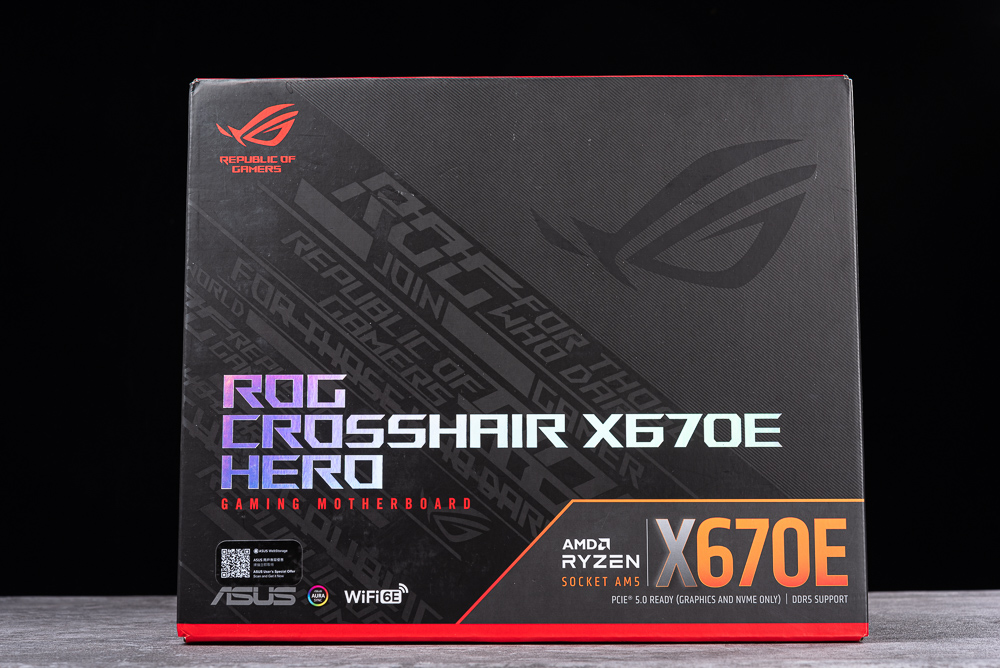
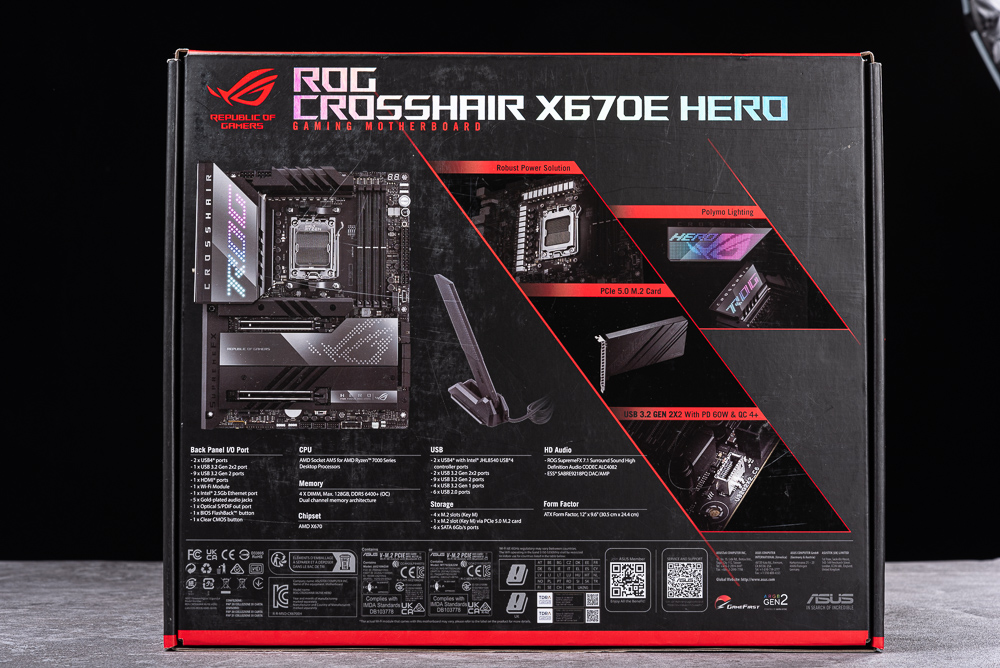
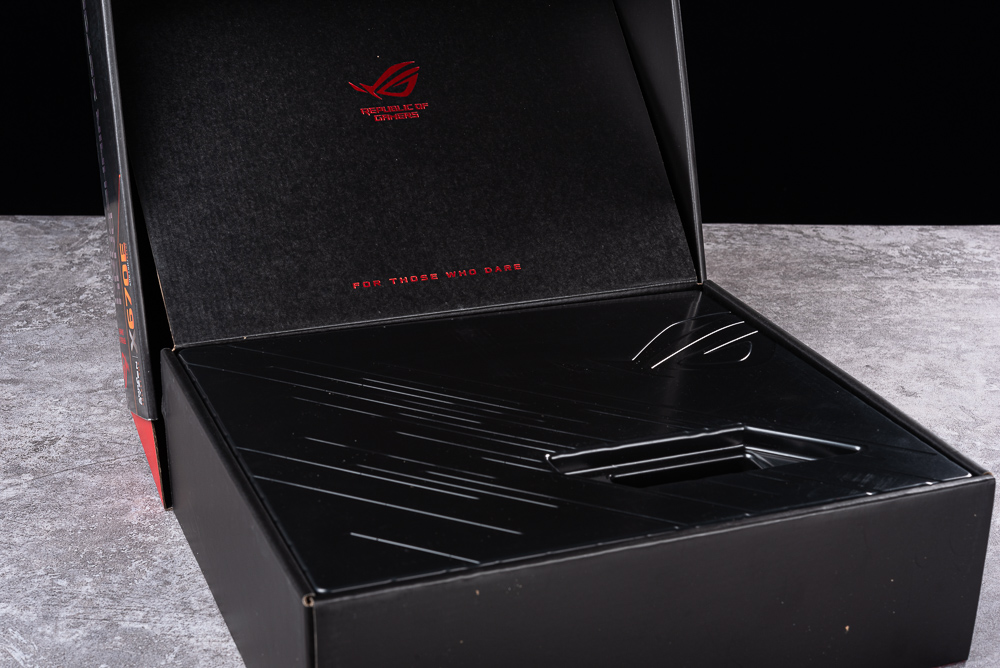
ROG CROSSHAIR X670E HERO has the same blackening style, with mirror and dot matrix ROG logo, as well as the enlarged VRM heat sink and the first M.2 heat sink of this generation, are also much higher; and all the DIY convenience of X670 Design, such as the Q-Release button of the first PCIe slot, M.2 Q-Latch and other functions are also available in the X670E HERO.
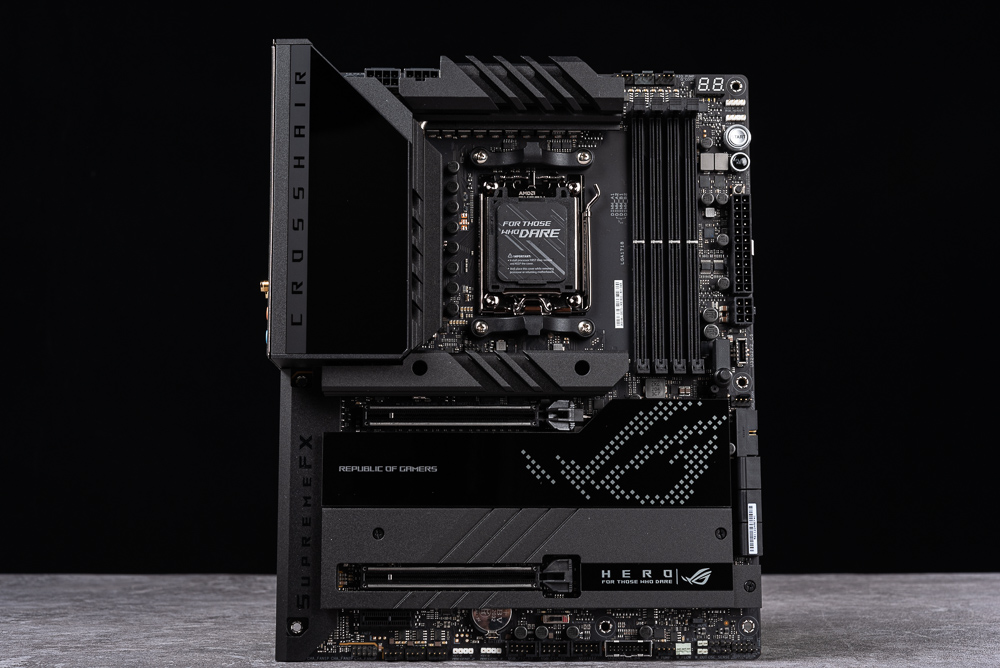
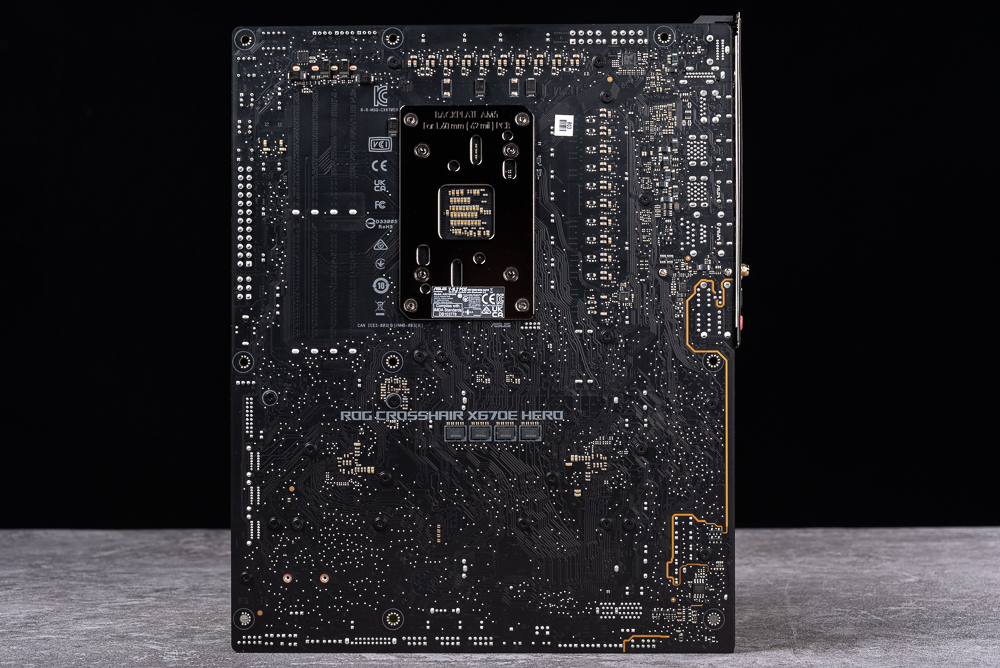
There are 4 DIMM DDR5 memory slots in the upper right corner of the motherboard, as well as an ATX 24-pin and PCIe 6-pin power supply, this 6-pin is to provide 60W PD/QC4+ fast charging for front USB 3.2 Gen 2×2 Type C use.
Also because of the height of the first M.2 heat sink and the large size of the graphics card, it has become very difficult to press the buckle of the PCIe slot when removing the graphics card and interface card. Therefore, ROG uses a physical switch. Extend the clip of the first PCIe slot to a separate button in this area, which makes it easier to remove and install the graphics card.
And this area also has functions such as power, Flex Key, Retry button, RGB pins, Debug Code / LED, and CPU FAN.
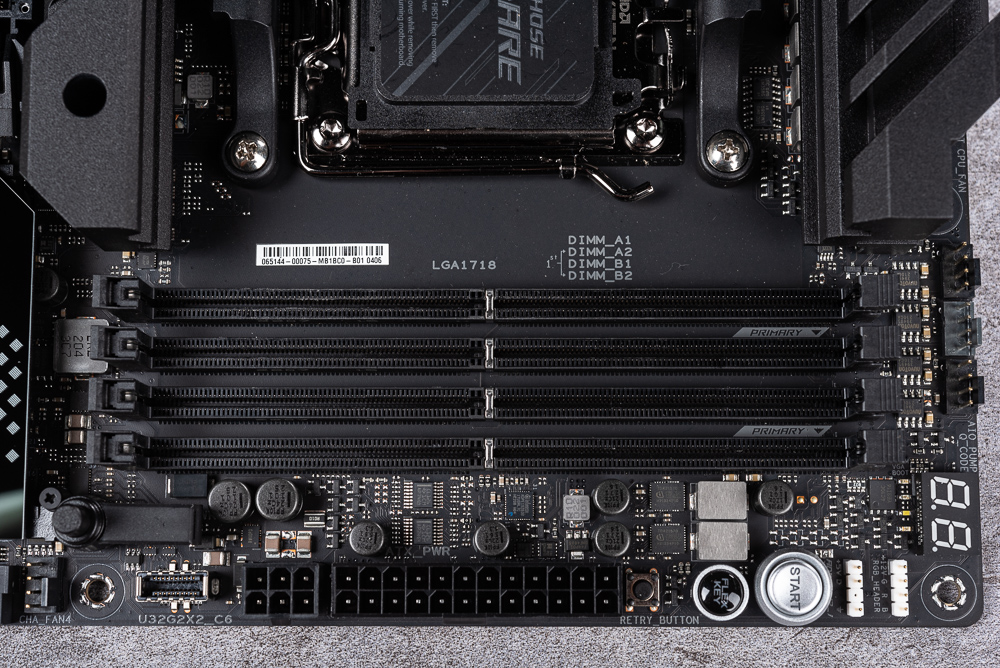
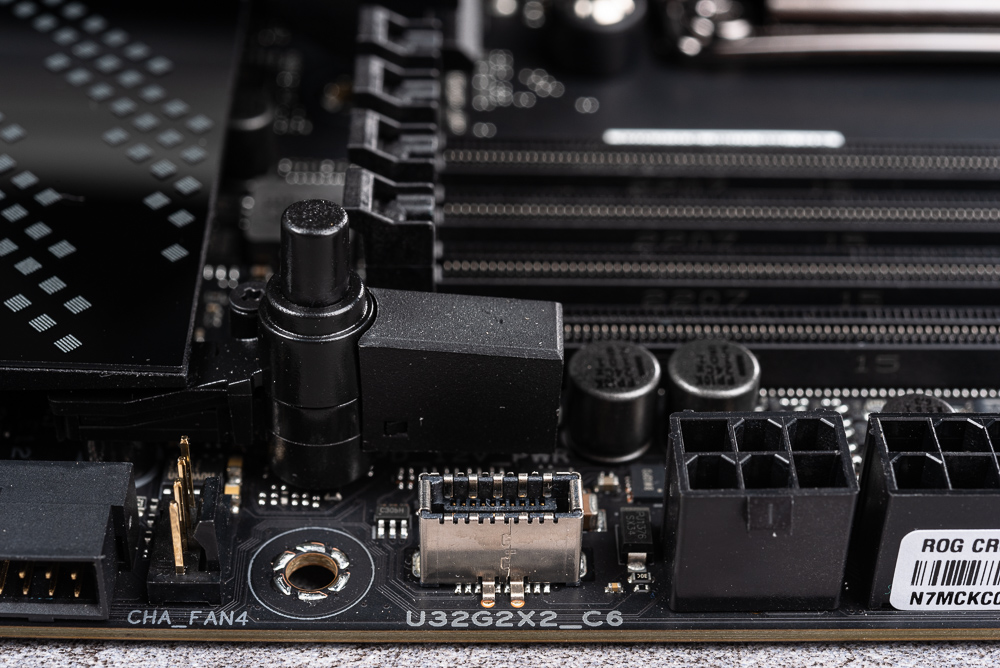
AM5 and LGA1718 pins are compatible with AM4 heatsinks, and there are XX phase power supplies and large VRM heatsinks around the CPU socket. Two sets of heatsinking fins are connected in series by heat pipes, and the left heatsink fins extend to I /O under the shell, greatly improving the passive cooling capacity of the VRM.
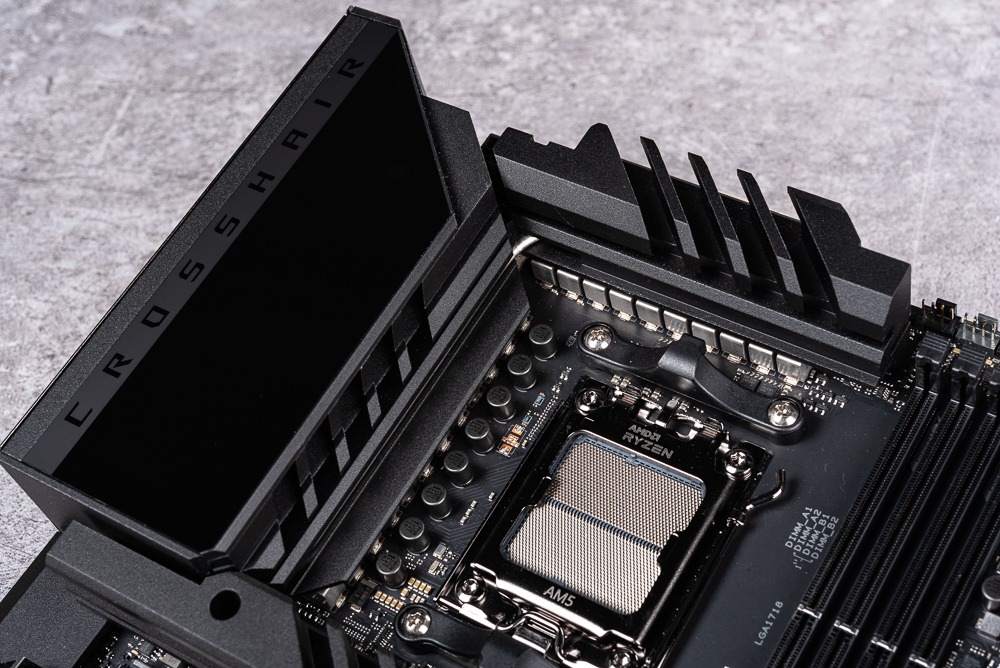
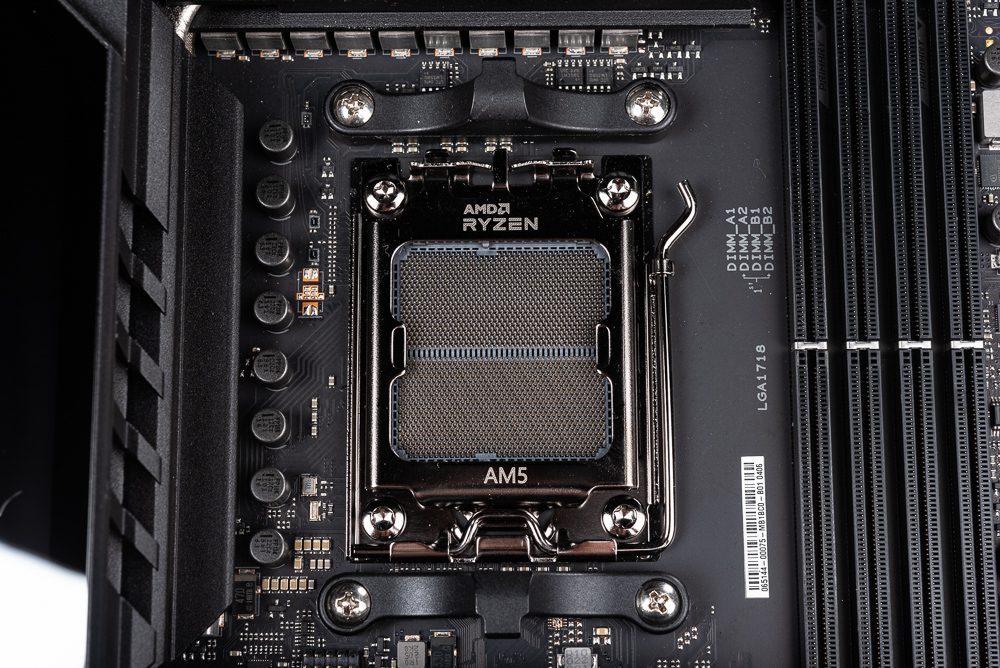
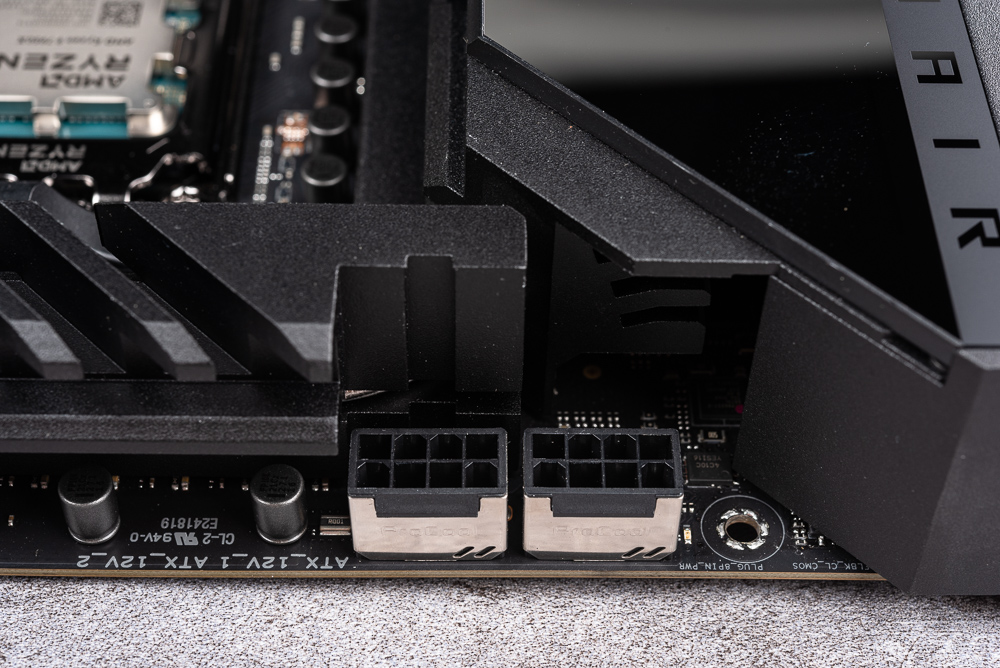
The lower right corner of the motherboard has 6 SATA ports, USB 3.2 Gen 1 internal FNA socket.
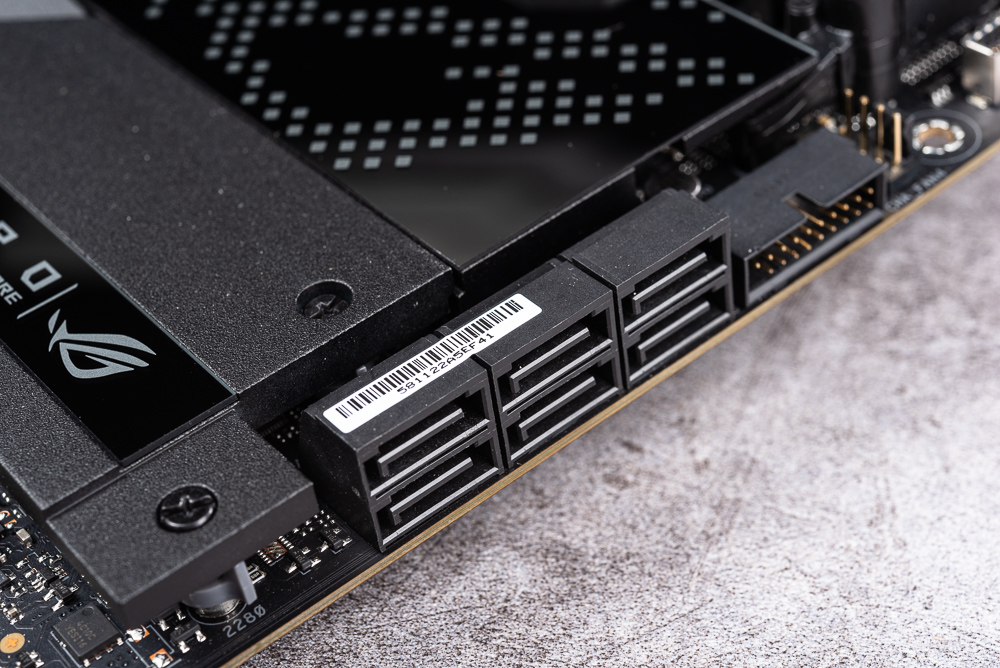
The motherboard’s PCIe slot and PCH heat sink design, mirror black and dot matrix ROG logo heat sink, plus 2 M.2 heat sinks, make the X670E HERO also have a very handsome appearance.
The first and second PCIe slots use the PCIe 5.0 x16 lanes provided by the CPU, and support single-card x16, and dual-card x8/x8 lane splitting. The accessories include a PCIe 5.0 M.2 interface card, which can be used to expand M.2 PCIe 5.0 x4 SSD.
The ports from left to right on the edge of the motherboard are front audio, FAN, RGB, 3 x USB 2.0, USB 3.0, DIY water cooling pins, and front panel pins.
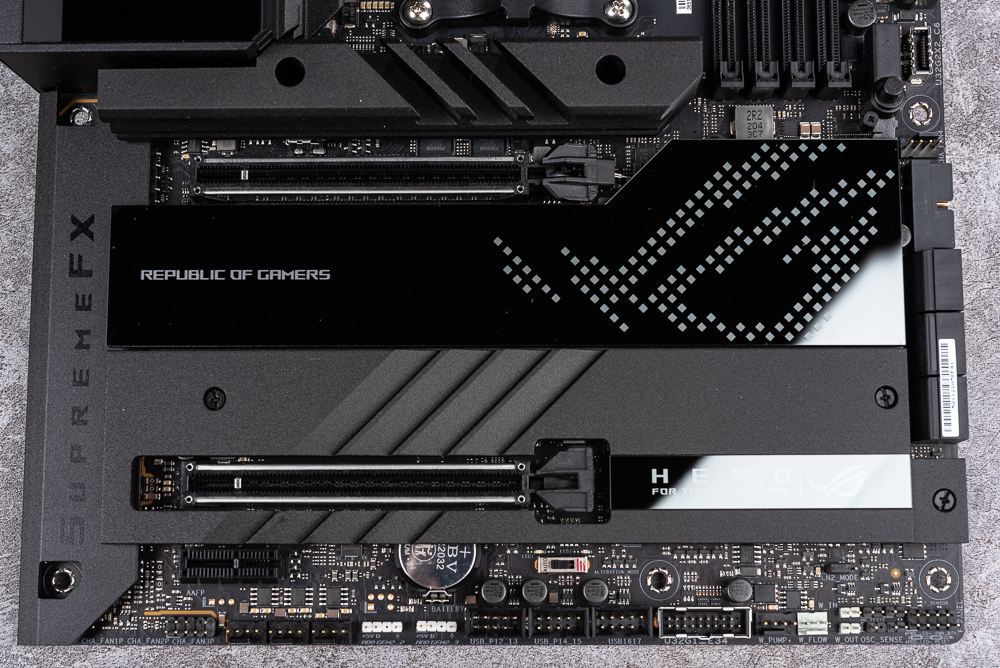
After removing the M.2 heatsink, the first M.2_1 under the CPU has heatsinks and thermal pads on the bottom in addition to the front heatsink. The first M.2_1 supports CPU PCIe 5.0 x4 lanes; then the second one on the left hand side The root M.2_2 has the same CPU PCIe 5.0 x4 channel, while the right-hand M.2_3 and M2_4 both use the chipset PCIe 4.0 x4 channel.
The 4 M.2 slots on the motherboard are equipped with M.2 Q-Latch quick-installation SSD design; if the accessory PCIe 5.0 M.2 interface card is included, the X670E HERO can support up to 3 M.2 PCIe 5.0 Crazy expansion with x4 SSD and 2 PCIe 4.0 x4 SSDs.
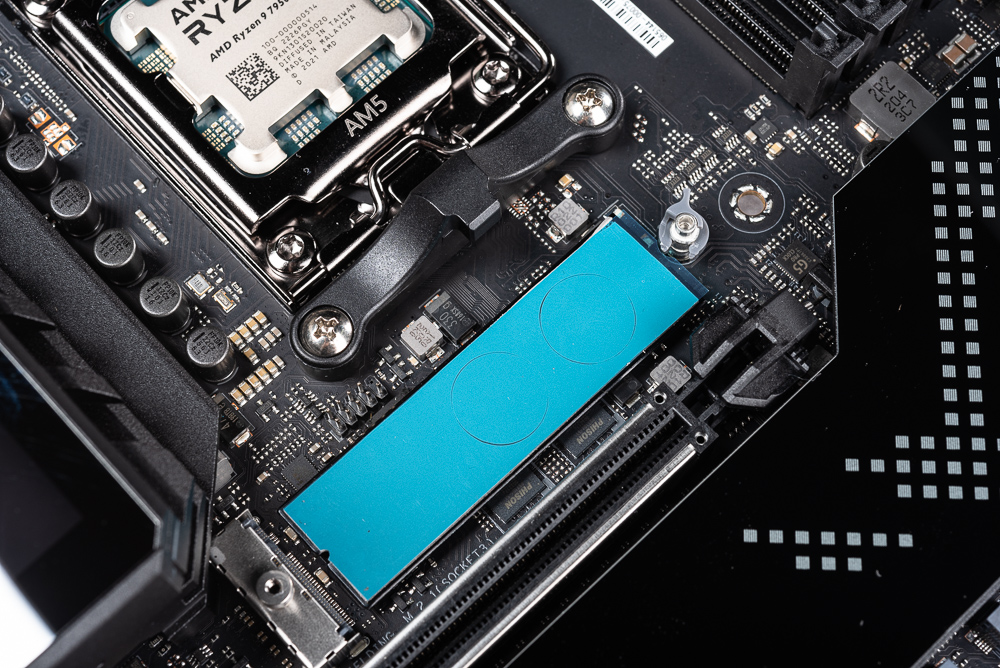
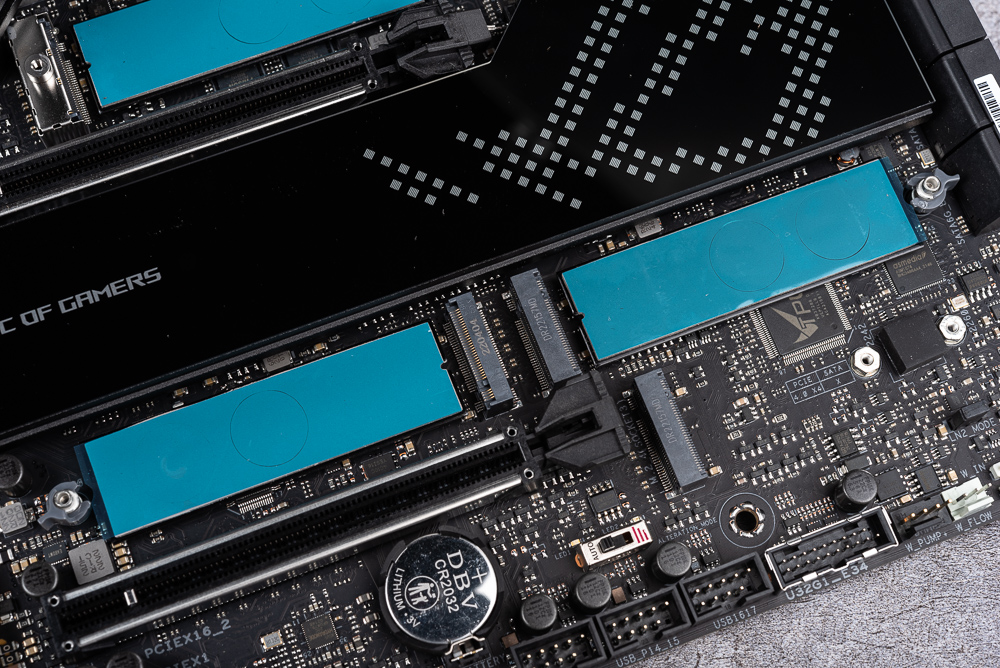
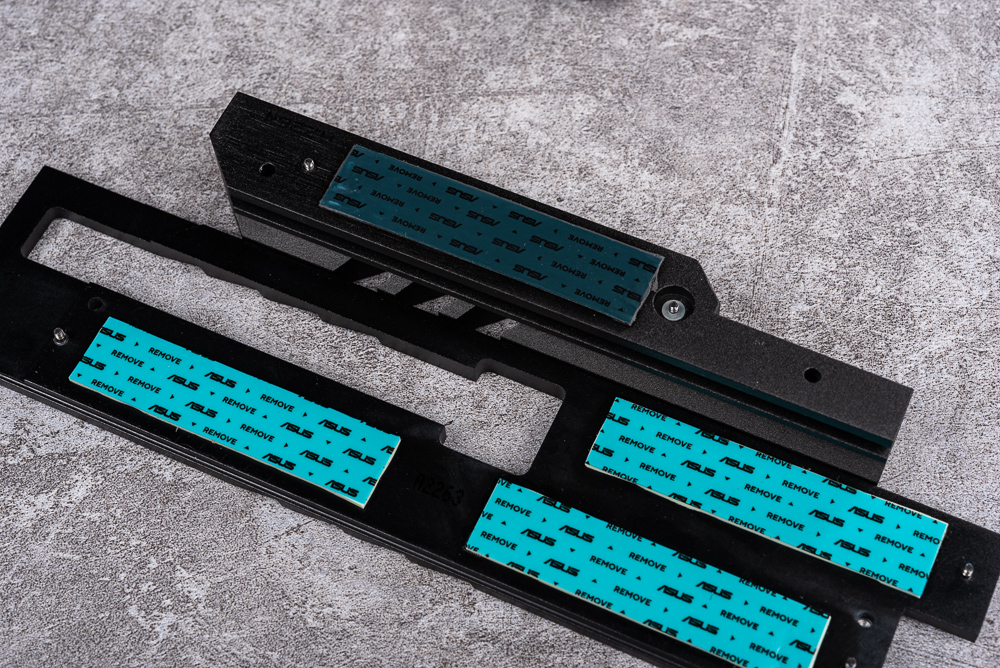
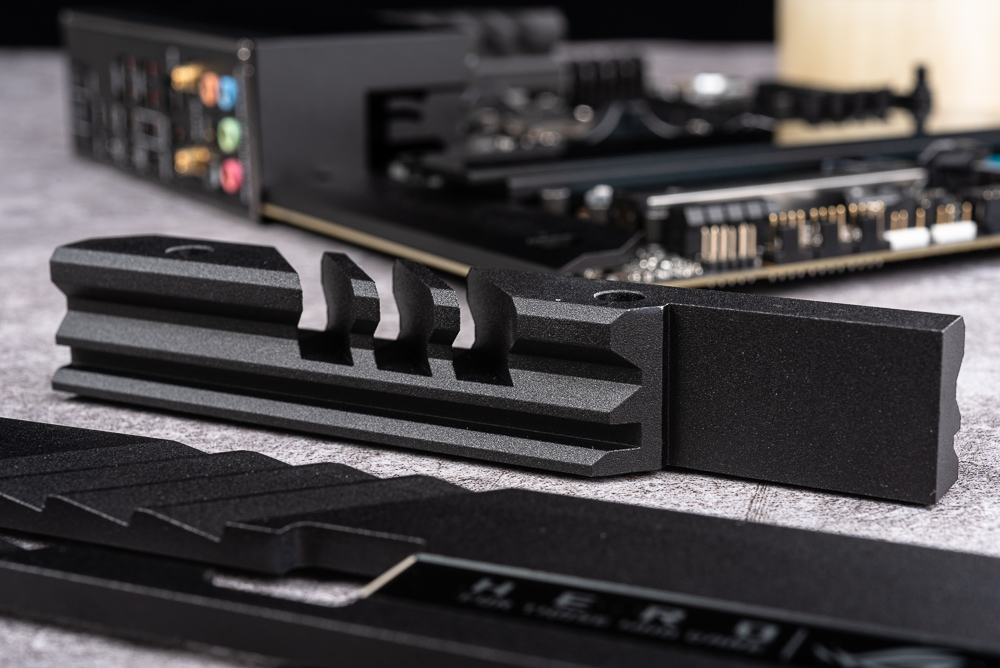
The rear I/O of the motherboard maintains an integrated backplane design, providing BIOS FlashBack and Clear CMOS buttons, HDMI, and 2 USB4 Type C, one of which supports DP output, 1 USB 3.2 Gen1 Type C supports DP output, and 1 USB 3.2 Gen 2×2 Type C, and 8 USB 3.2 Gen 1 ports, one of which is a white box representing the port used by FlashBack.
Of course, 2.5GbE RJ-45, Wi-Fi and 3.5mm 7.1 channels, SPDIF and other audio outputs are also available.
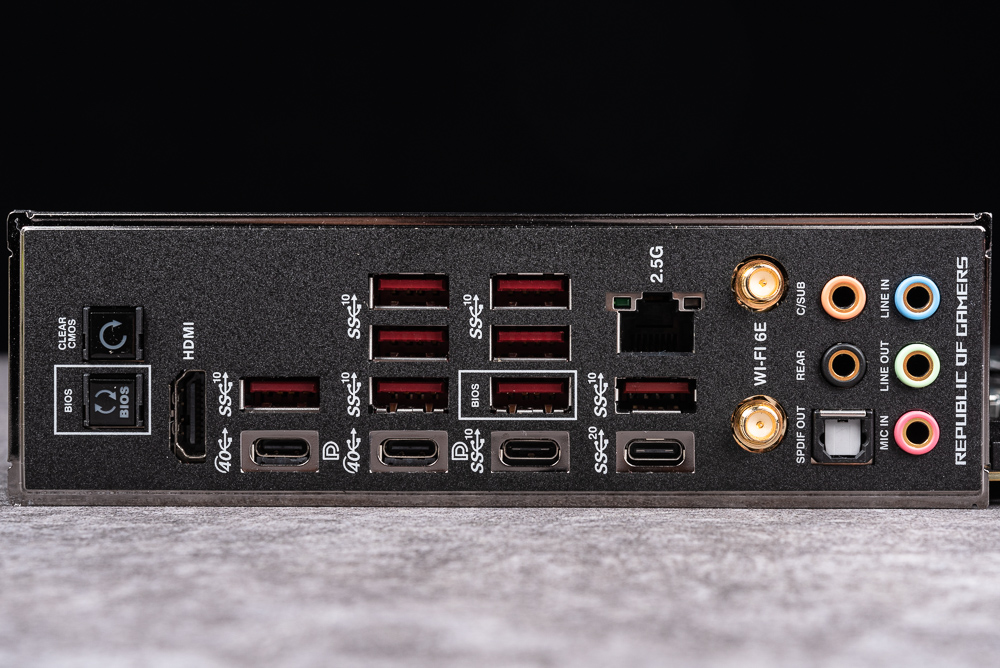
ROG CROSSHAIR X670E HERO Motherboard Material/ 18+2 Phase 110A, 5 x M.2, USB4, 60W PD/QC4+
ROG CROSSHAIR X670E HERO is fully functional, fully loaded with specifications, and does not require any channel splitting, which also makes expansion more convenient for players; and under the metal armor, this generation also hides many new components and small design details. Here I will disassemble the motherboard to share with you.
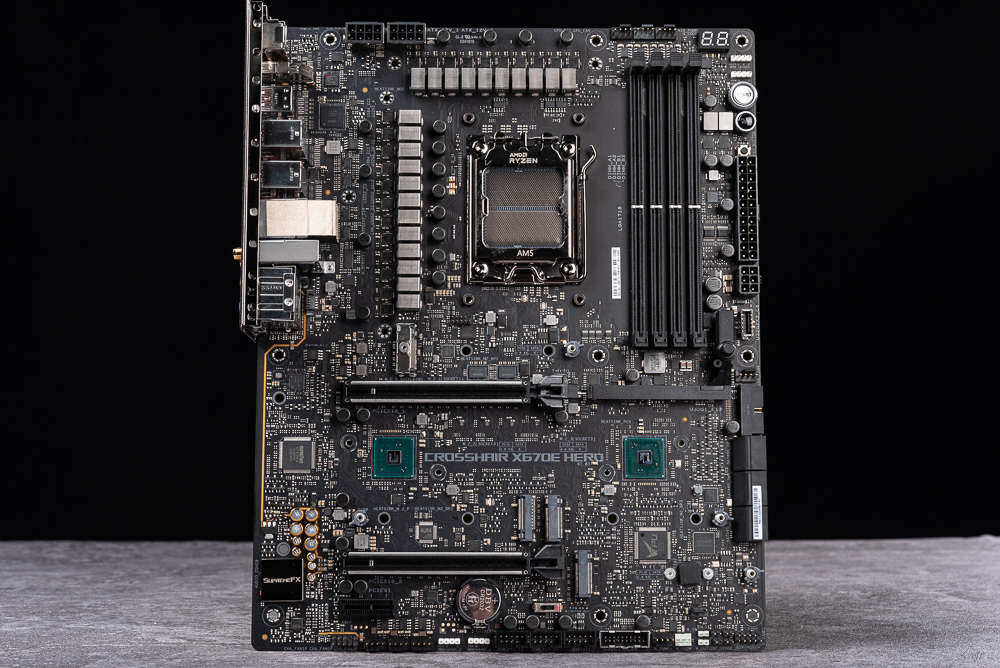

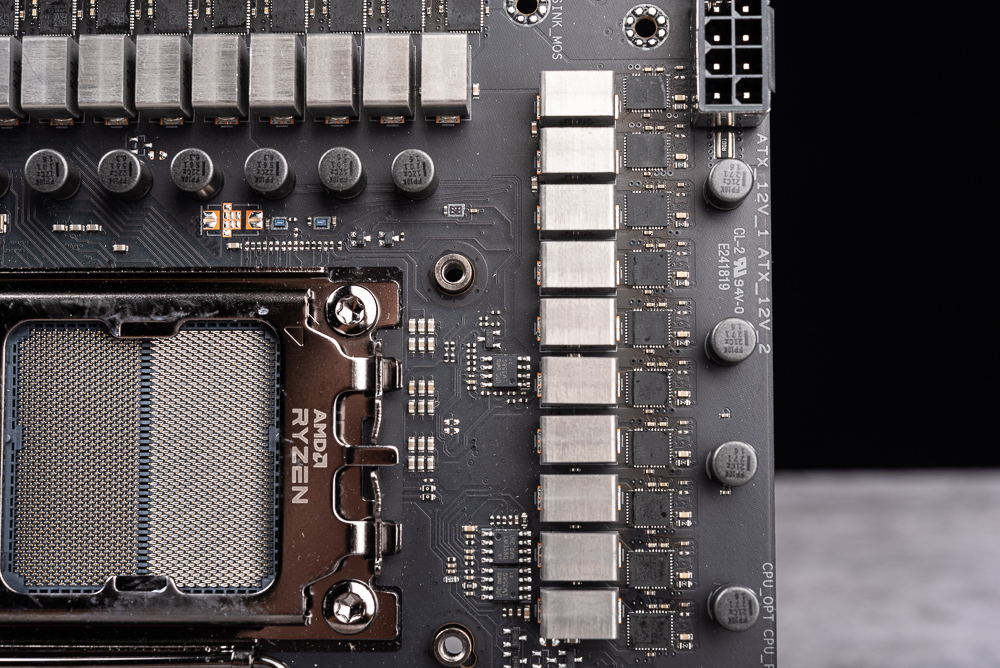
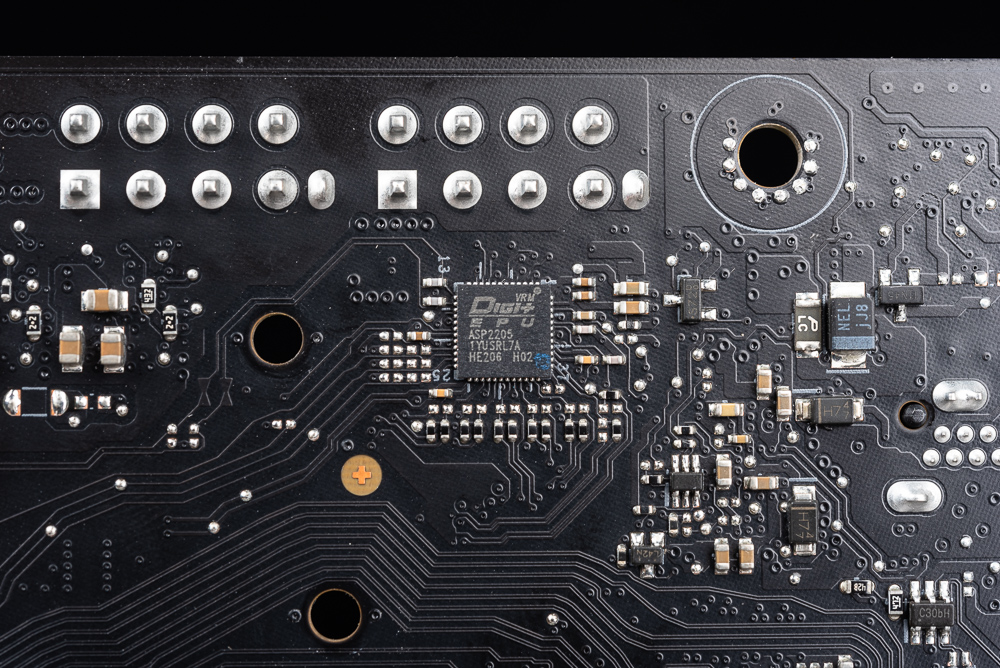
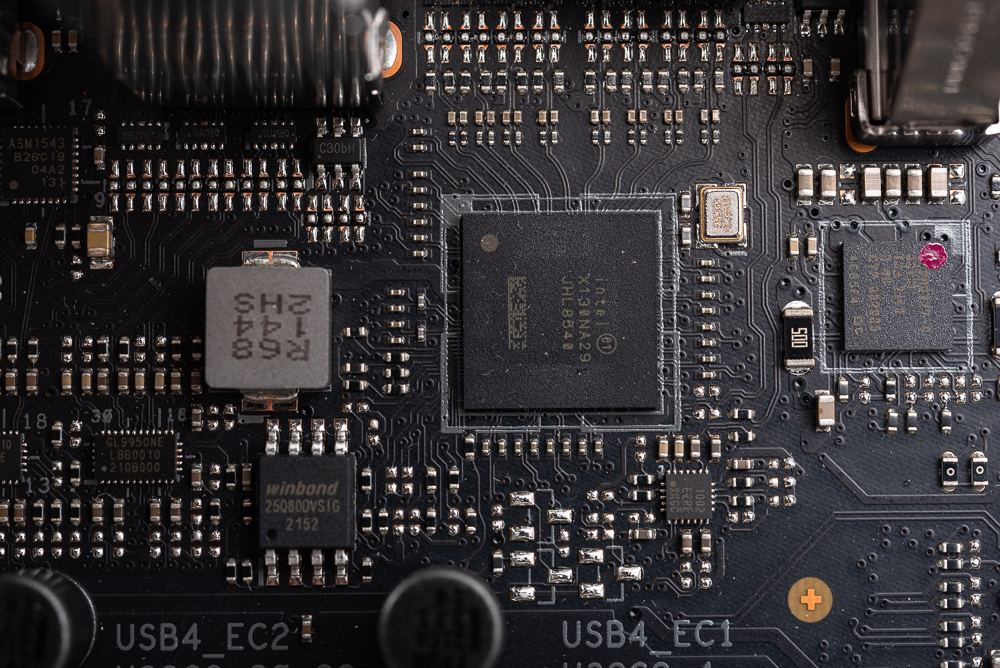
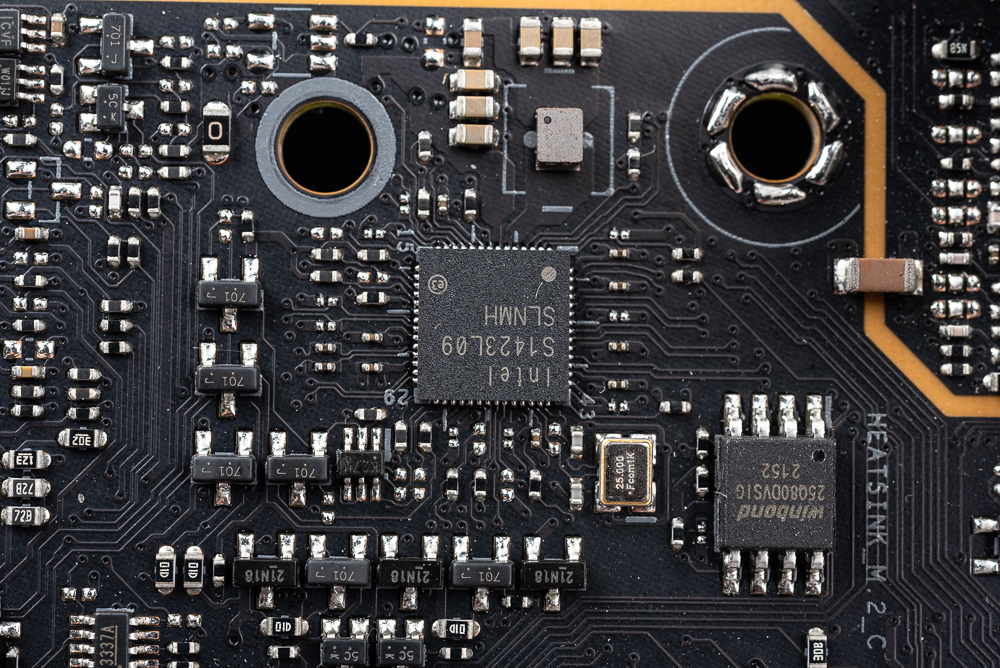
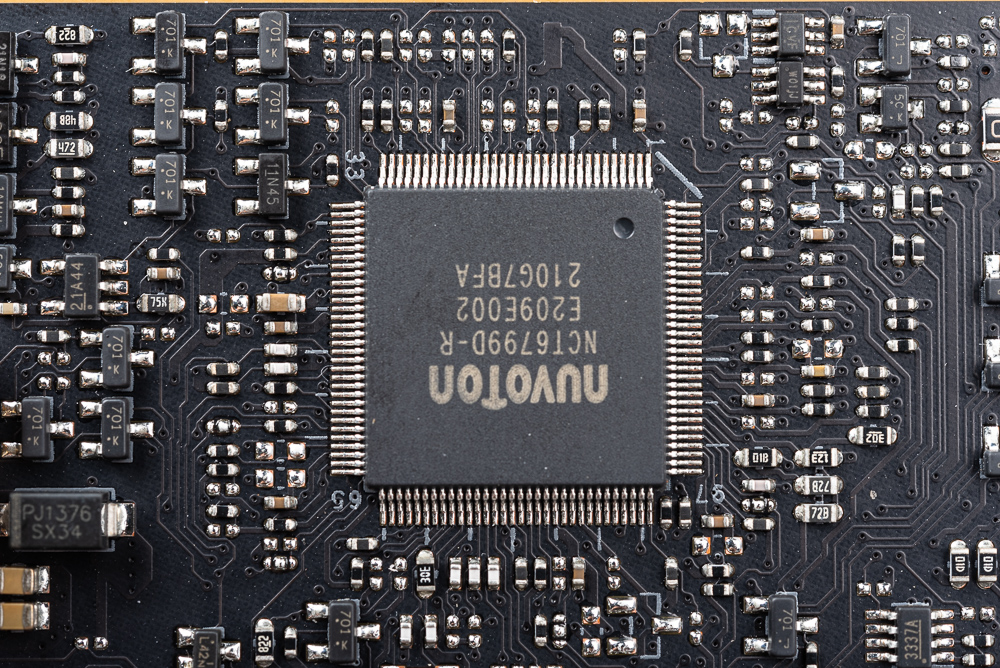
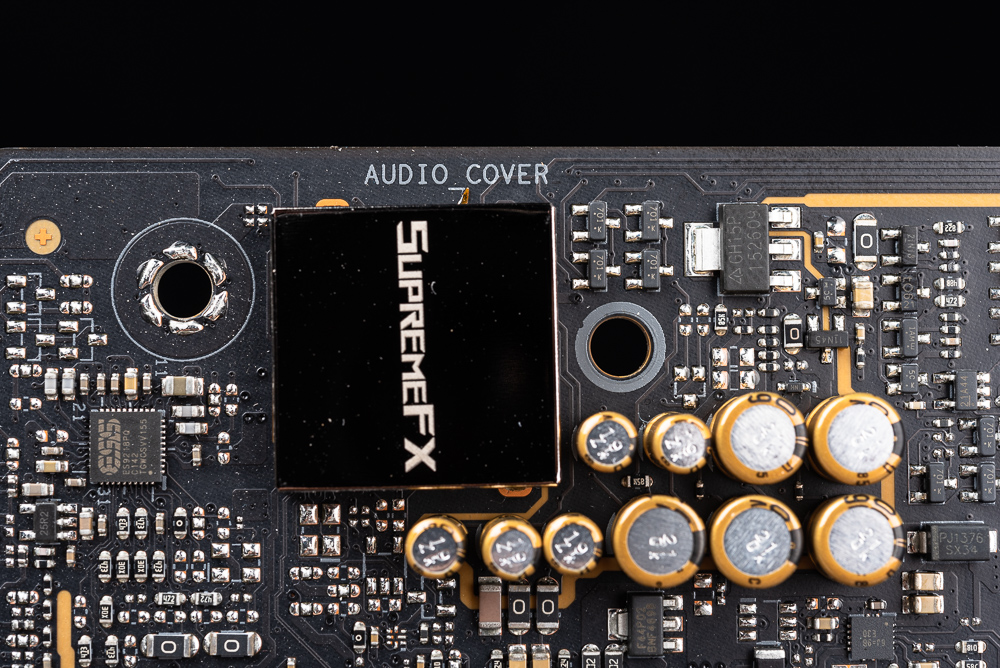
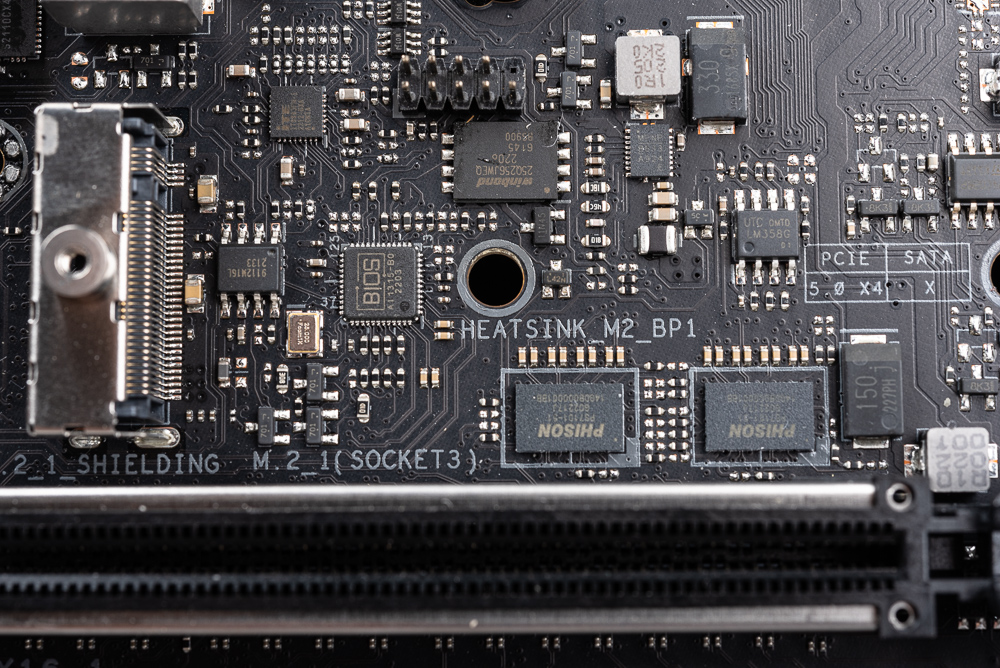
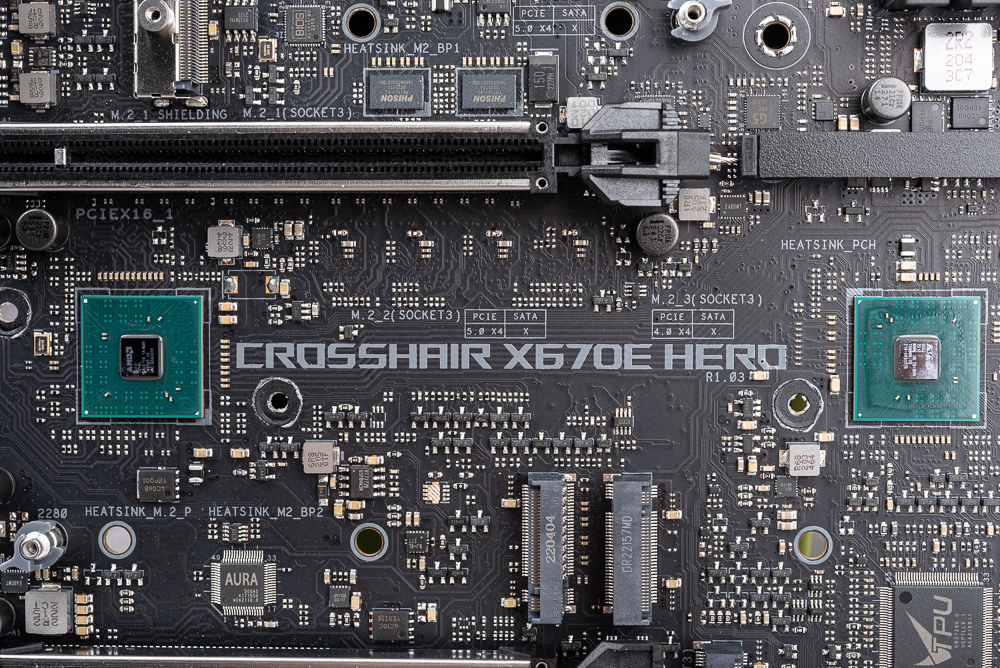

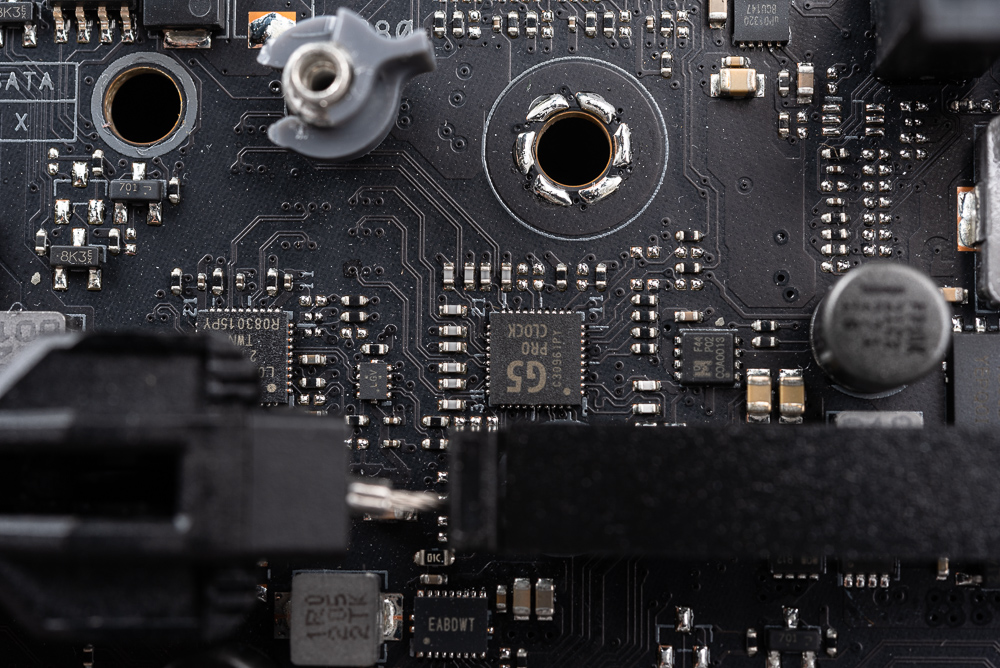
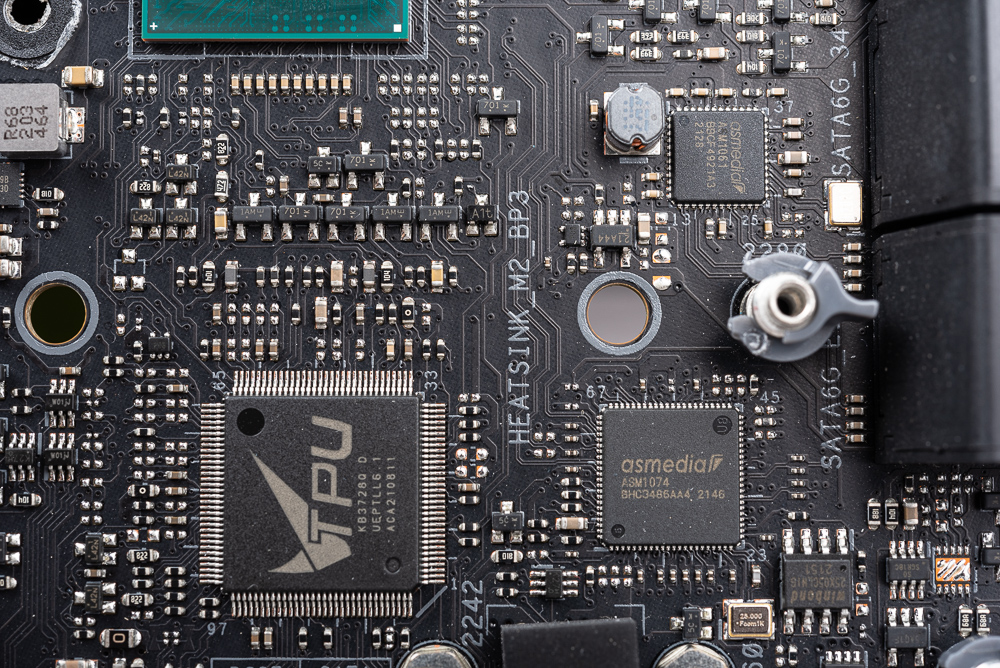
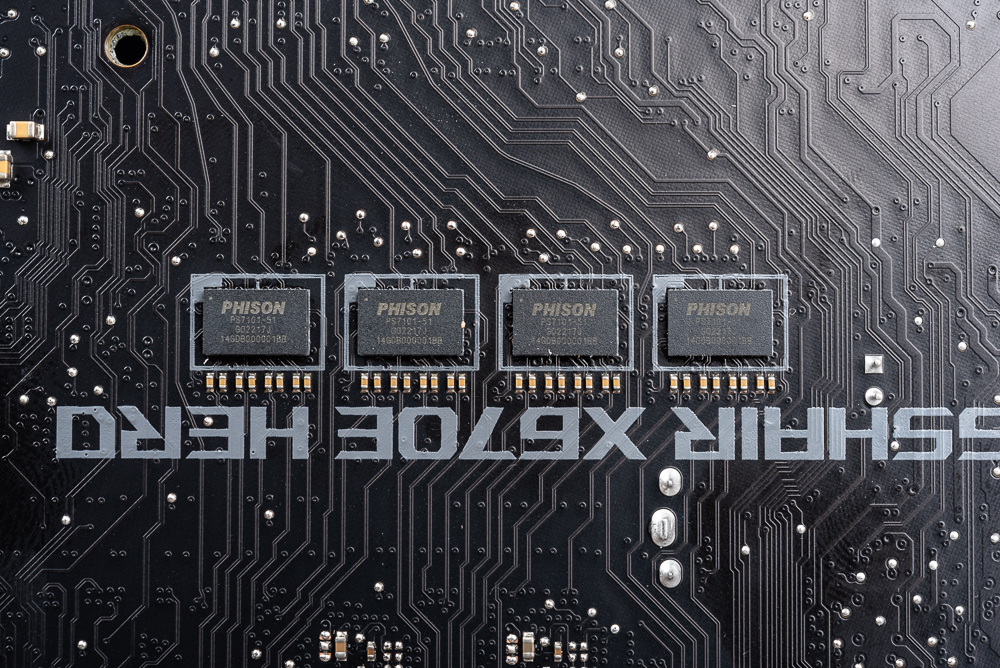
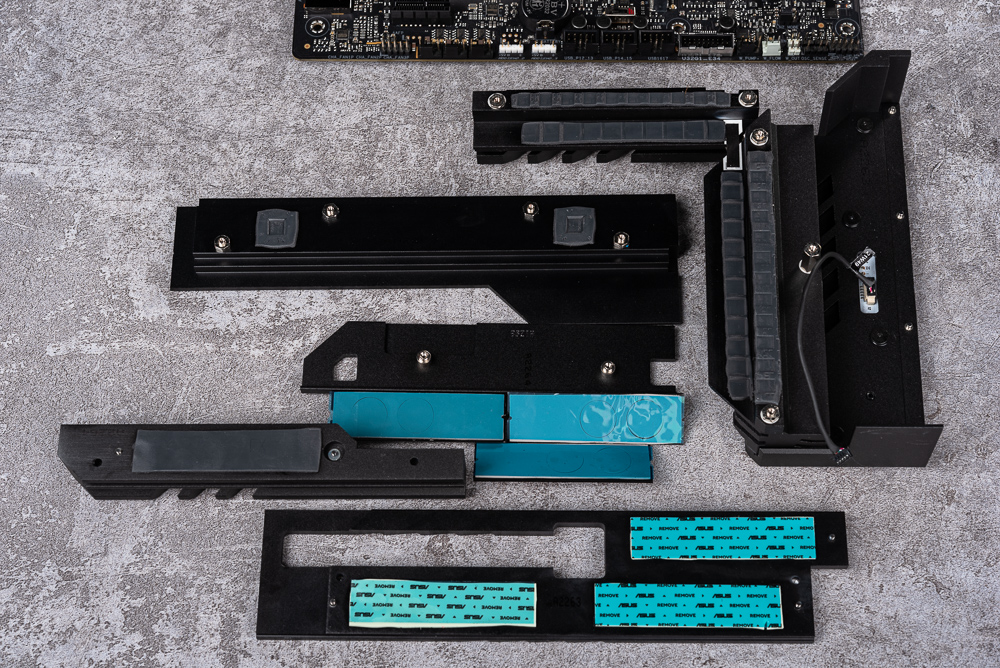
ROG CROSSHAIR X670E HERO Accessories/ Graphics Card Stand, PCIe 5.0 M.2 Card
X670R HERO also gives quite a lot of accessories, from basic manual, USB drive pen drive, sticker, thank you card, ROG key ring, PCIe 5.0 M.2 Card, graphics card bracket, Wi-Fi antenna, and SATA cable, RGB extension Wire, M.2 screws, etc.
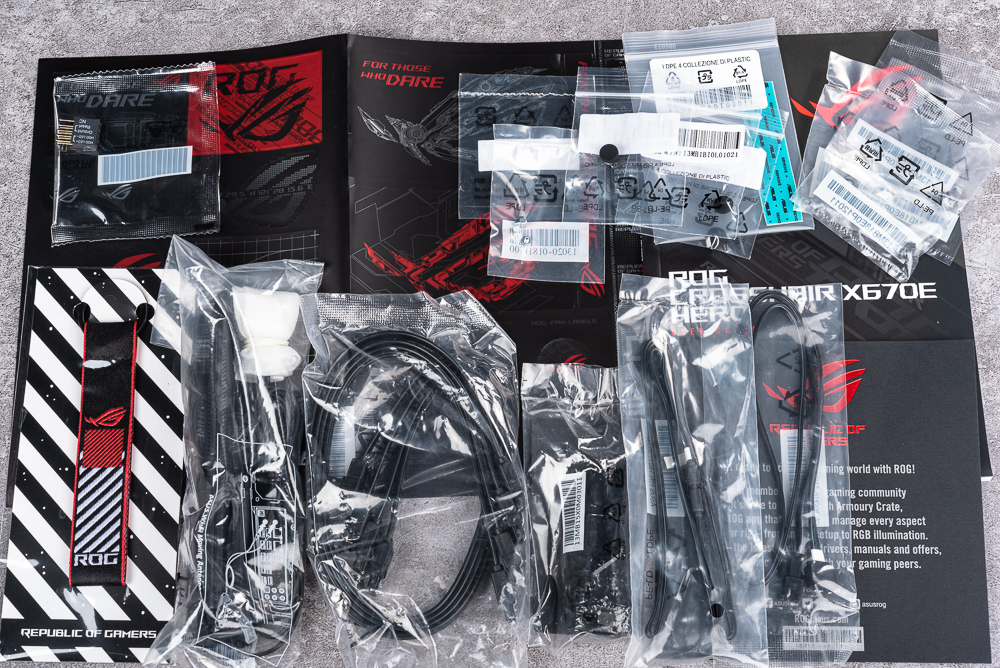

The entire front of the PCIe 5.0 M.2 Card is a heat sink, and has a consistent blackened and slanted line design. After disassembly, it mainly provides an M.2 PCIe 5.0 x4 SSD expansion, and there are thermal pads on the front and back.
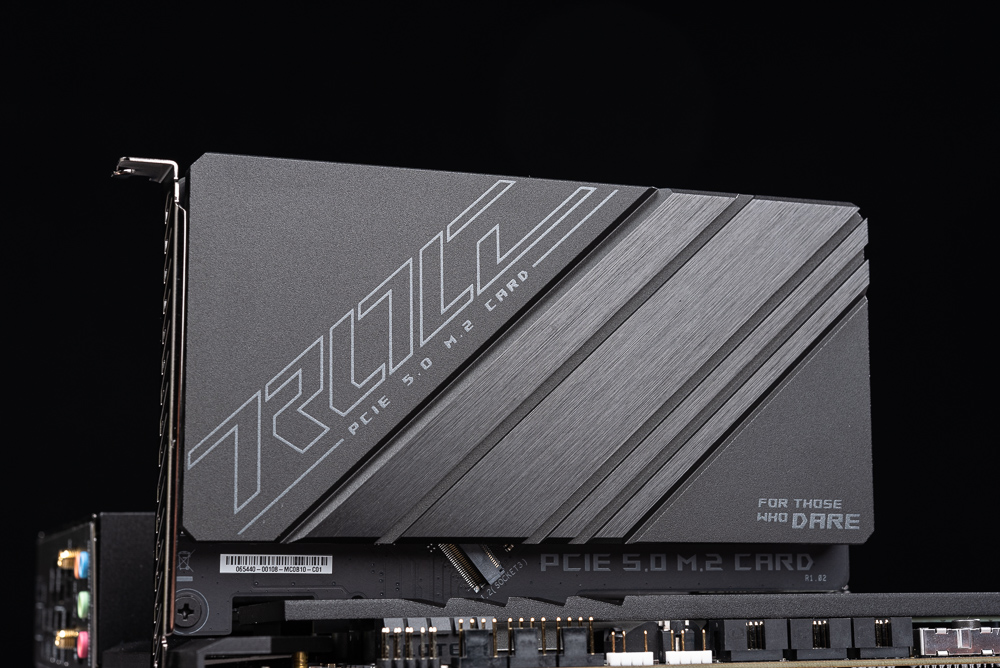
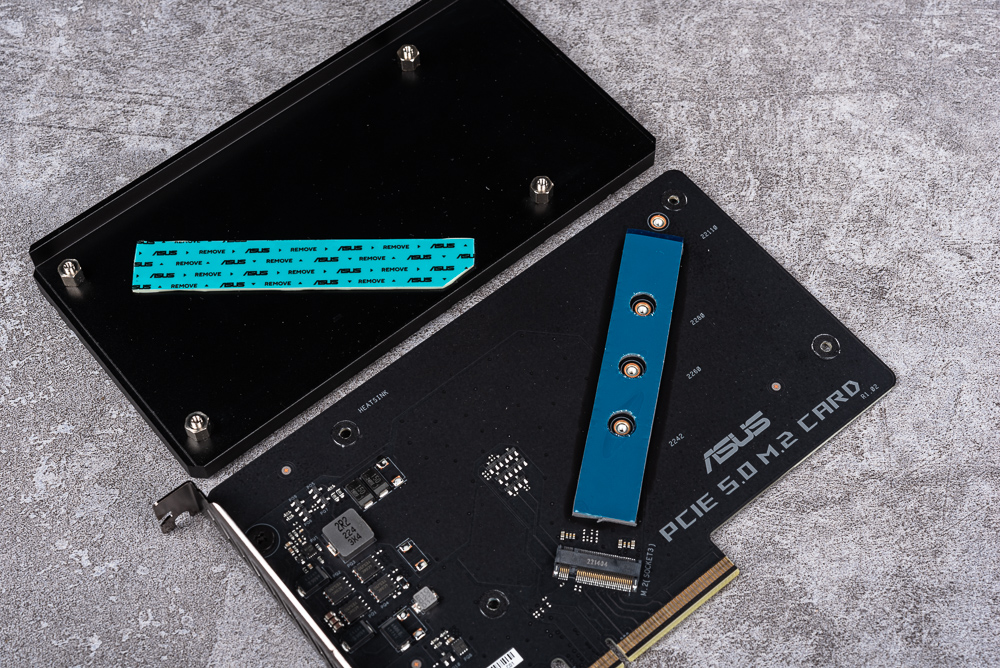
The ROG graphics card bracket is quite small, with a magnet at the bottom that can be attached to the chassis compartment, and an adjustable bracket to help support the graphics card; in addition, it can also be used as a card ejection tool for the PCIe clip.
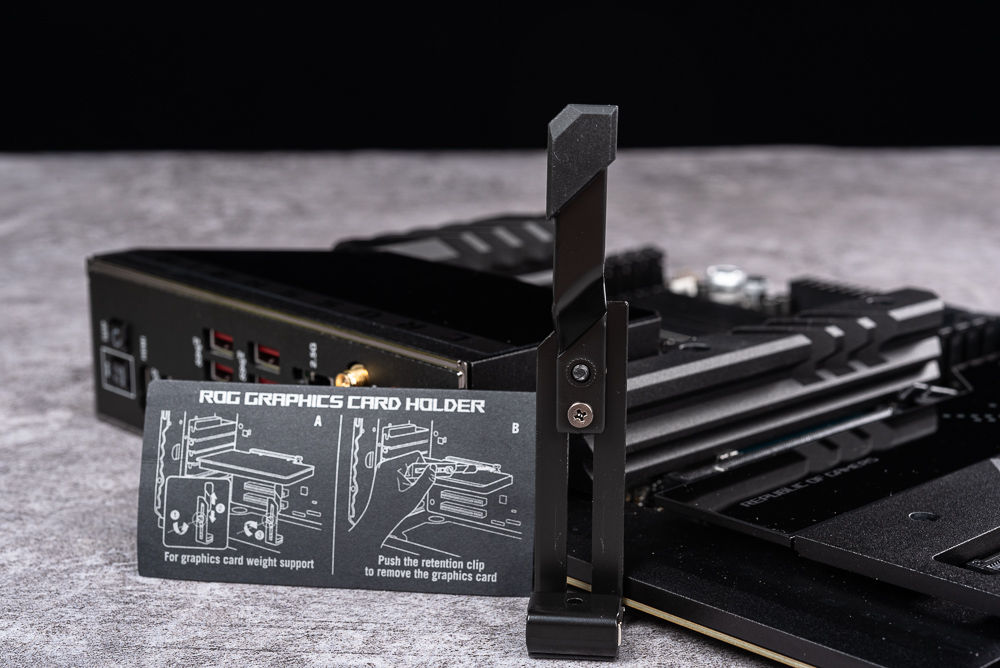
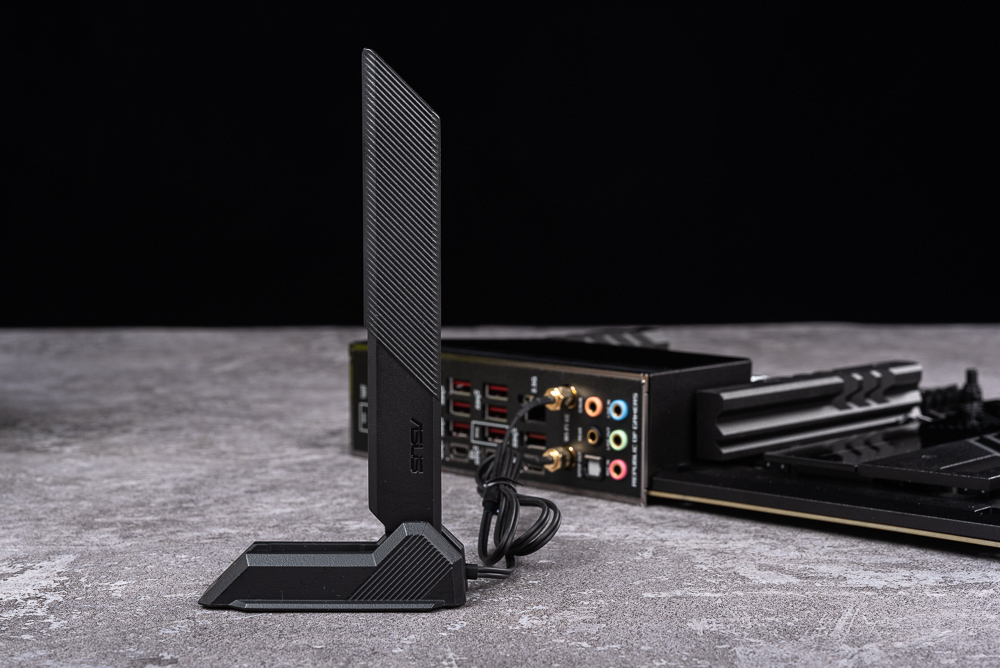
ROG CROSSHAIR X670E HERO BIOS Features / I also have AI overclocking
In ROG CROSSHAIR X670E HERO 0604 BIOS, Extreme Tweaker also provides AI smart overclocking EXPO, DOCP, and AEMP memory overclocking settings, and CPU Core Ratio also adds AI Optimized function in addition to the custom clock.
In addition, the “prediction” function on the right-hand side has finally been added to the AMD motherboard of ROG CROSSHAIR. The SP predicts that the CPU physique is usually above 90, which is a good physique. At the same time, it also evaluates the radiator performance (the higher the score, the better). It will give the maximum voltage value of 5142MHz and the basic voltage parameter of 4500MHz for the whole core.
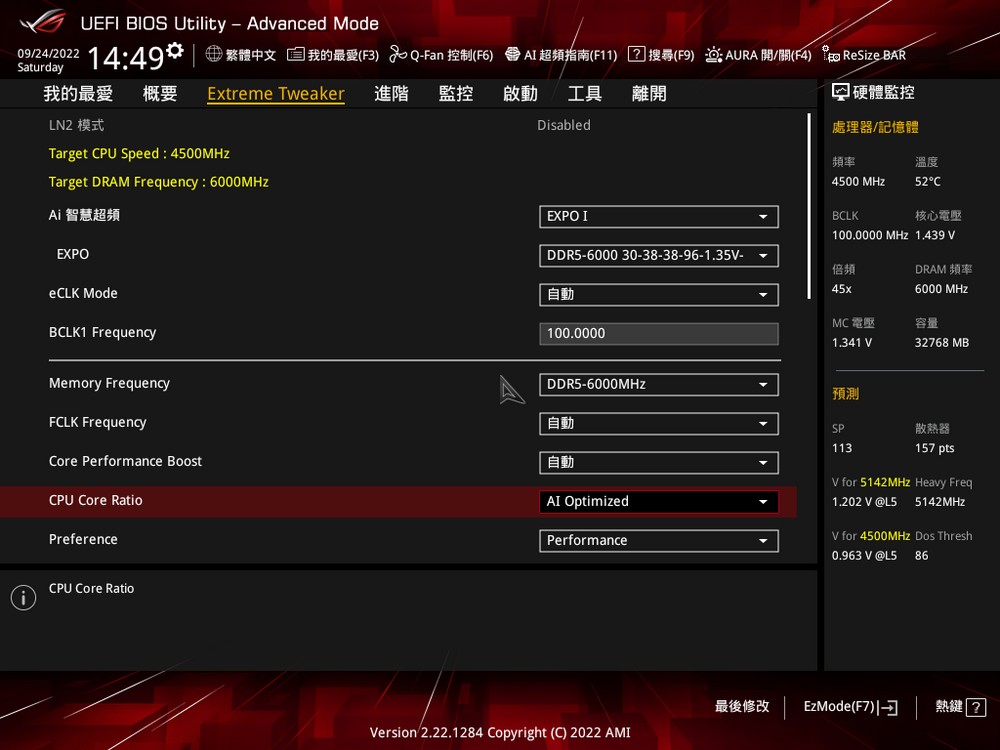
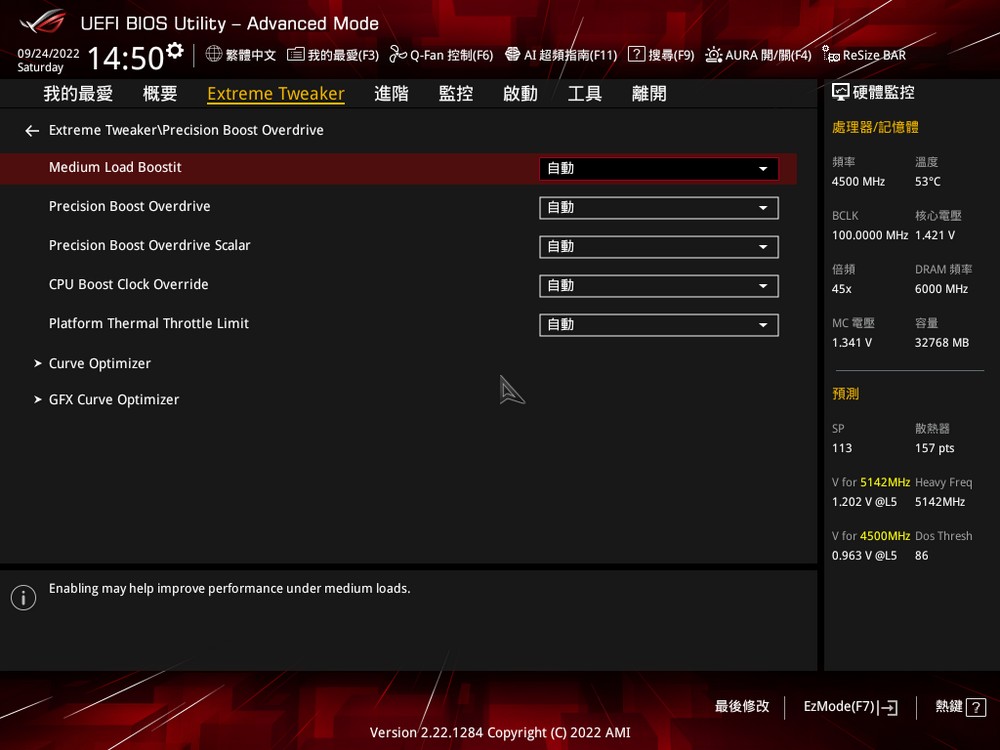
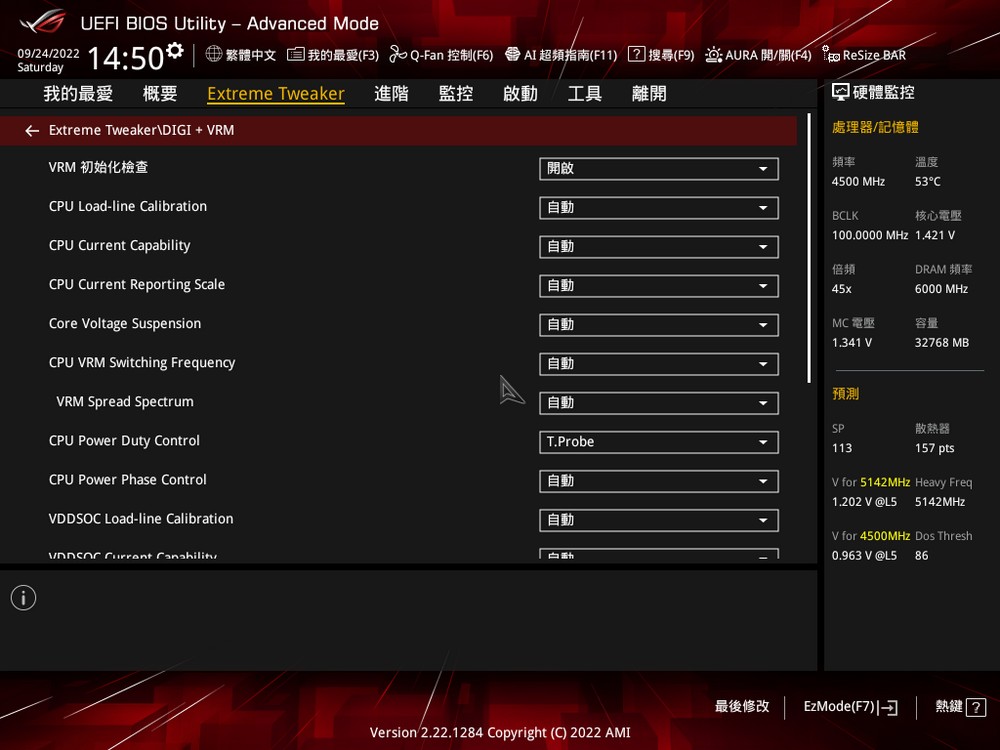
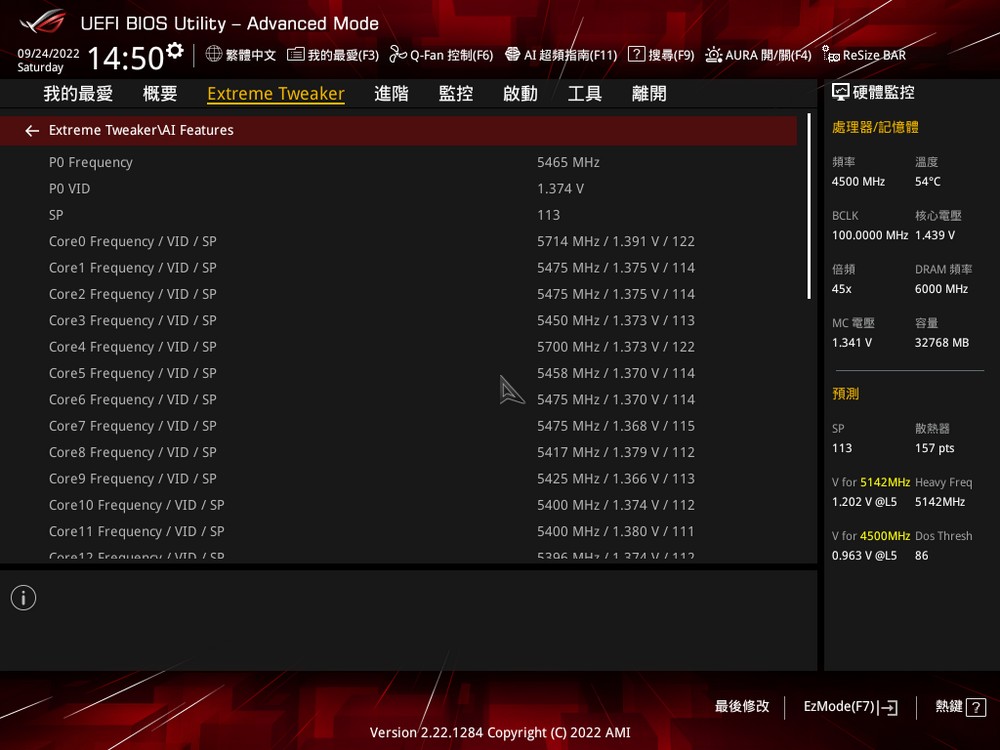
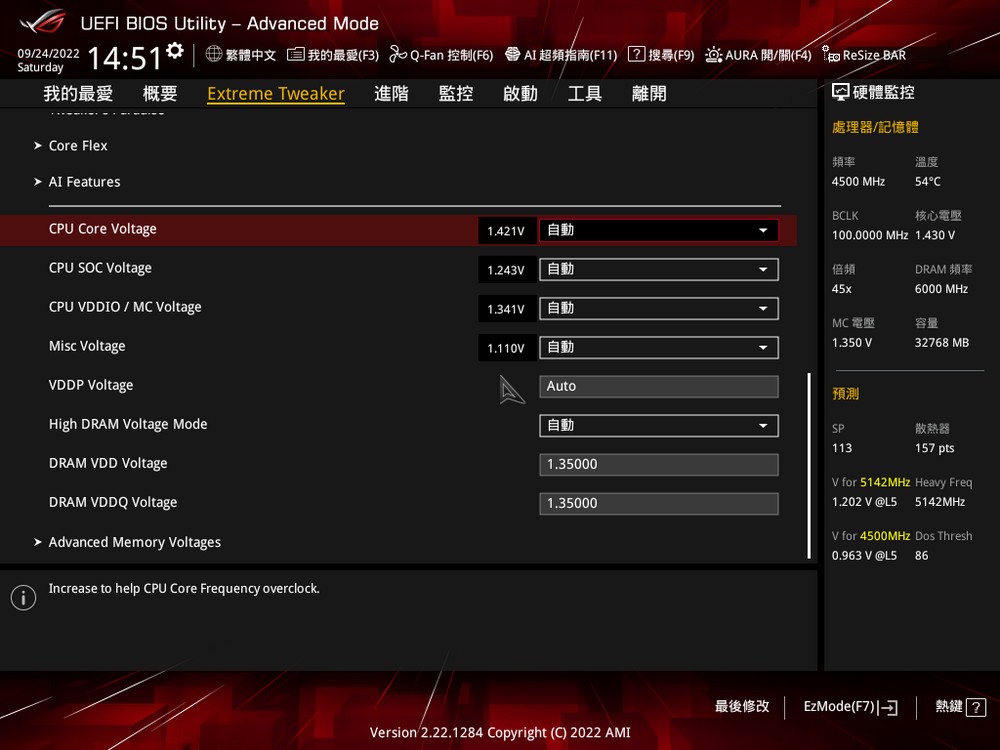
Advanced settings include processor settings, PCI subsystem defaults to enable the Resize BAR function, PCIe bandwidth branching for built-in devices, and PCIe connection speed settings.
In the north bridge setting, the internal display function of the Ryzen 7000 can be switched on and off.
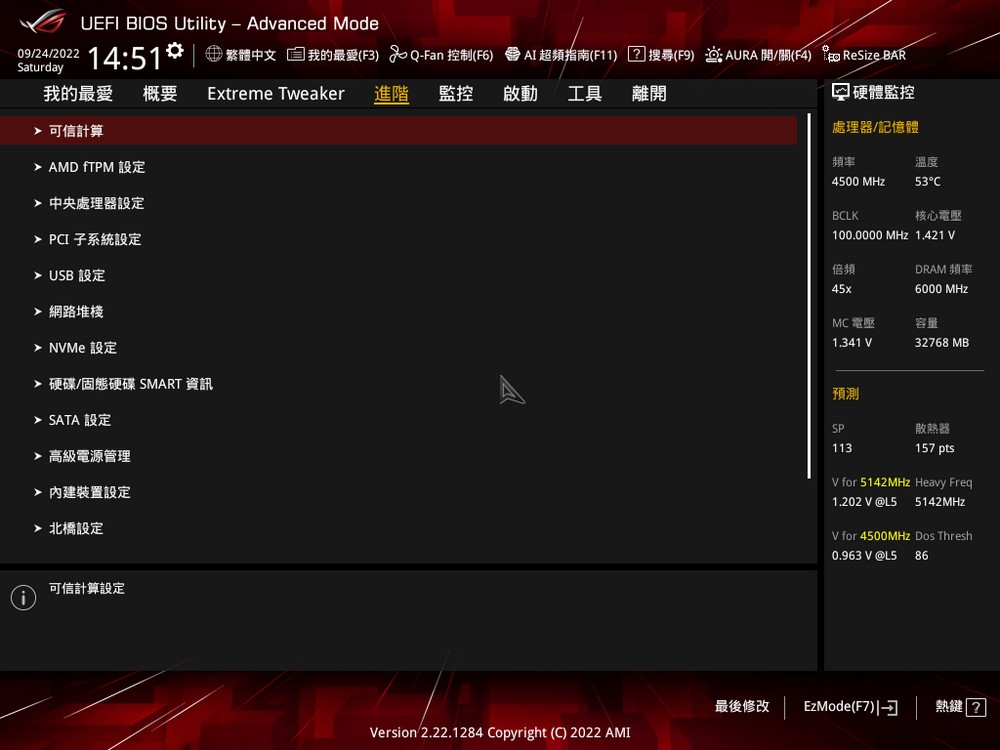
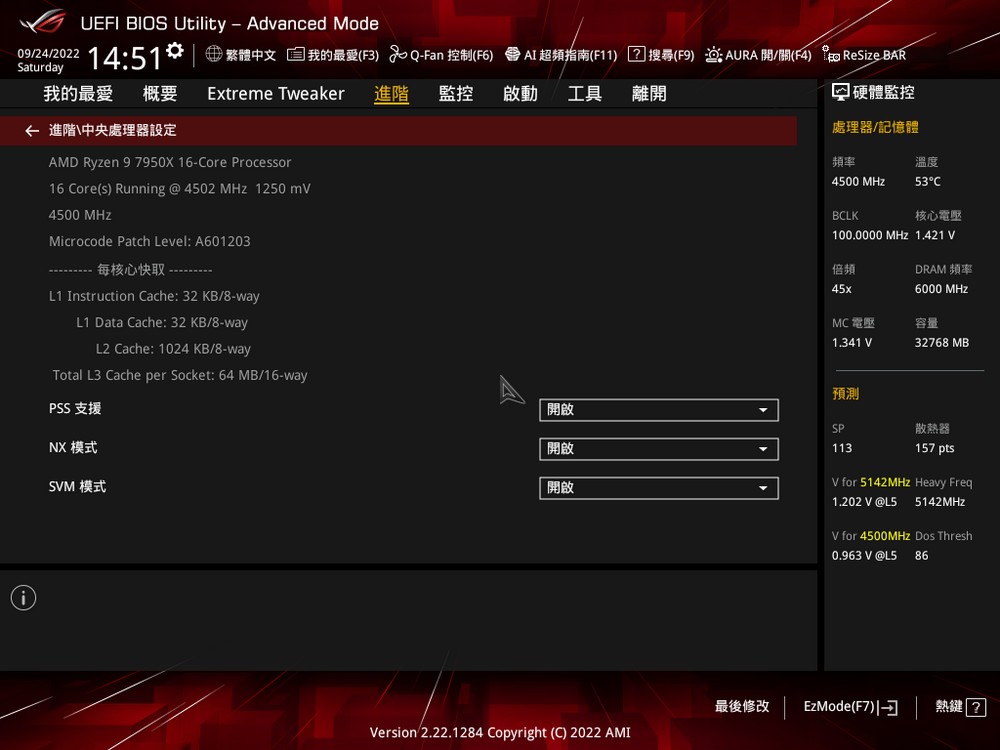
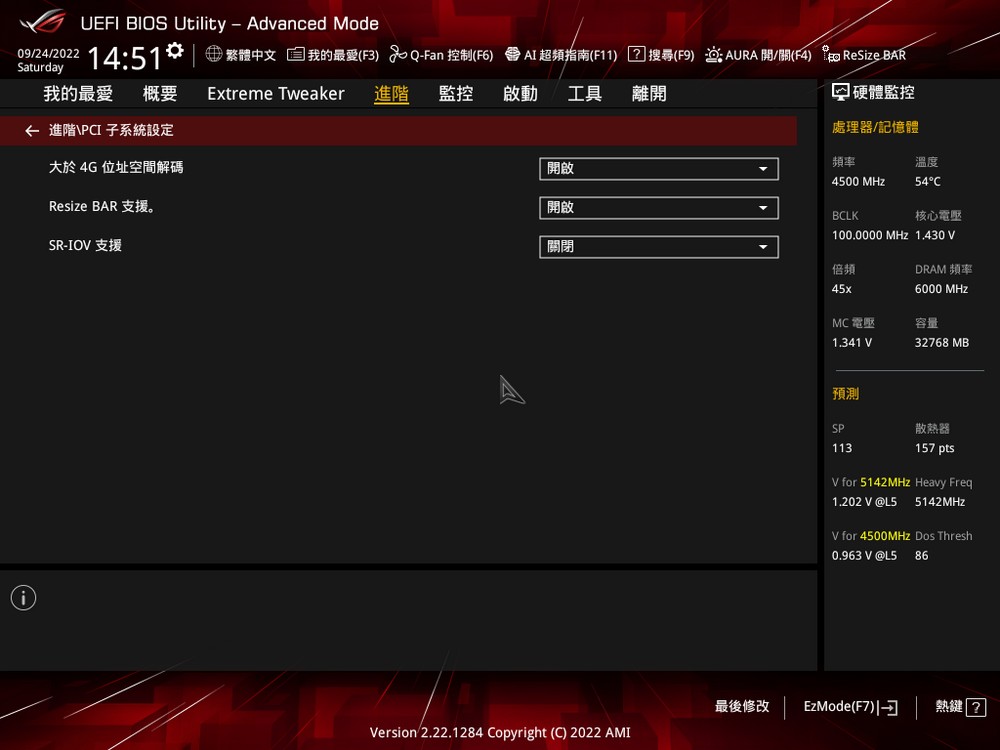
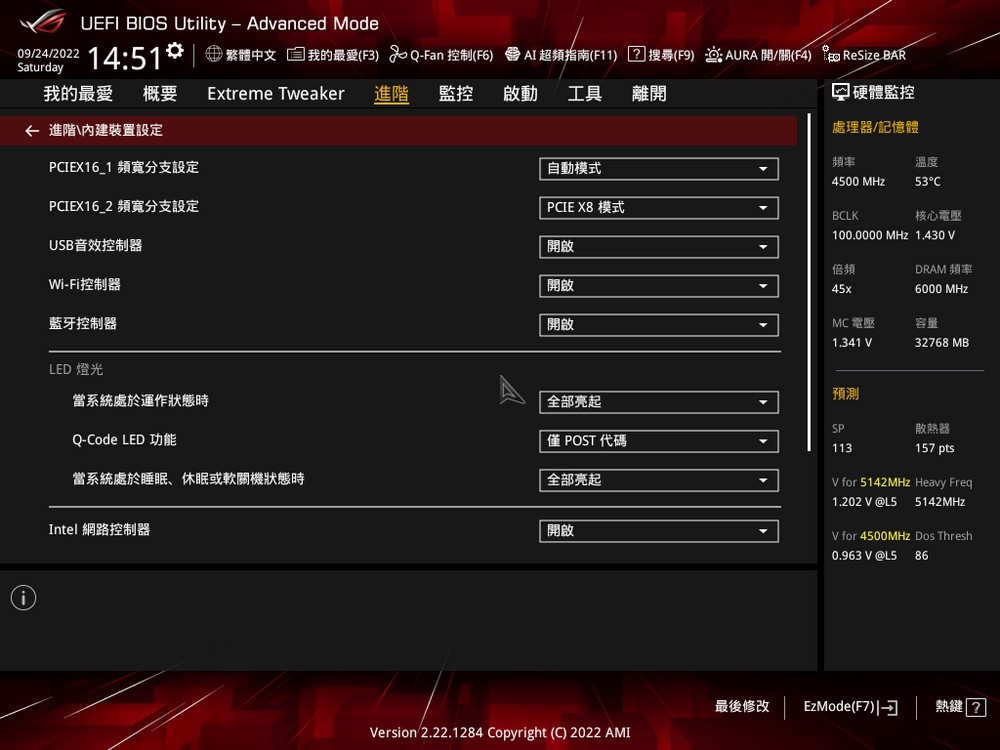
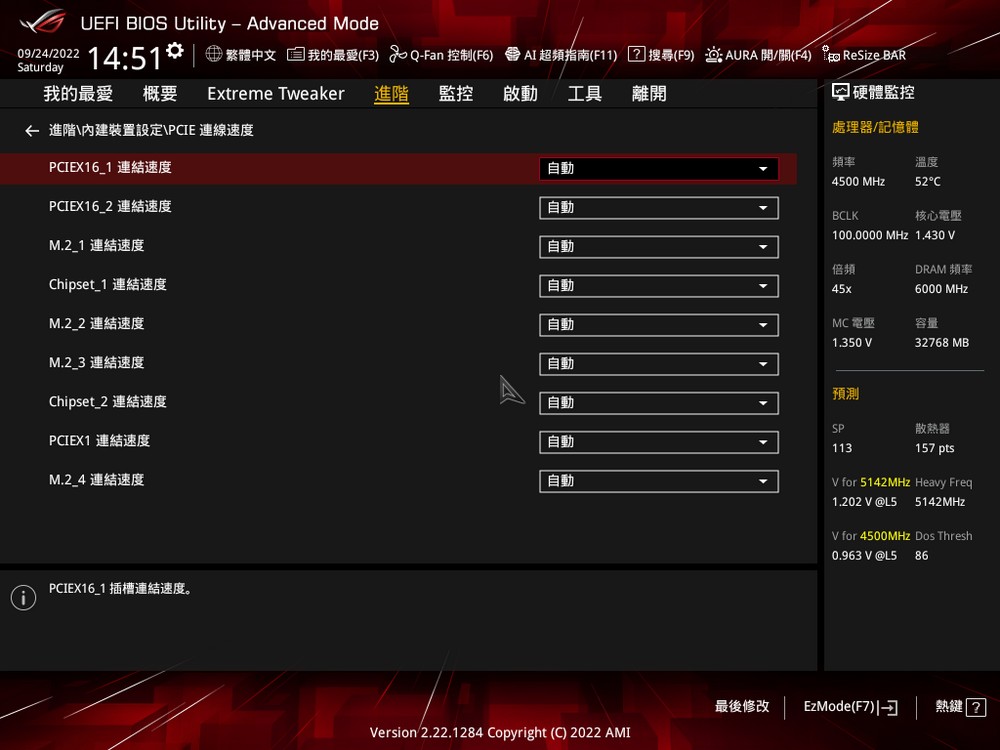
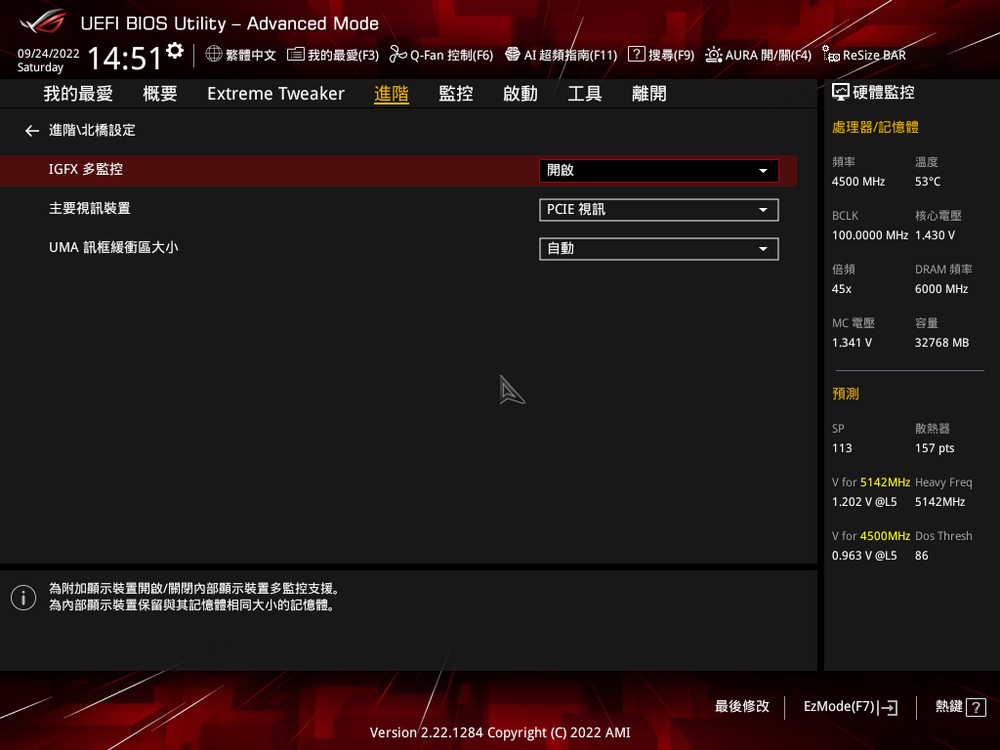
The monitoring functions are divided into settings such as temperature, fan speed, voltage and Q-Fan.
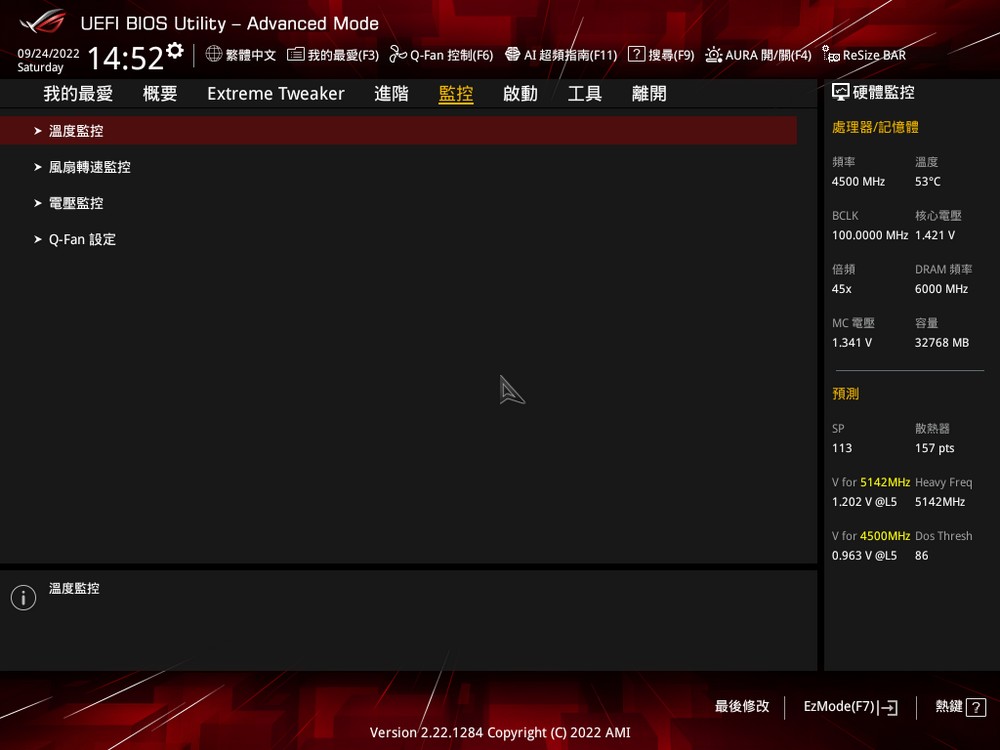
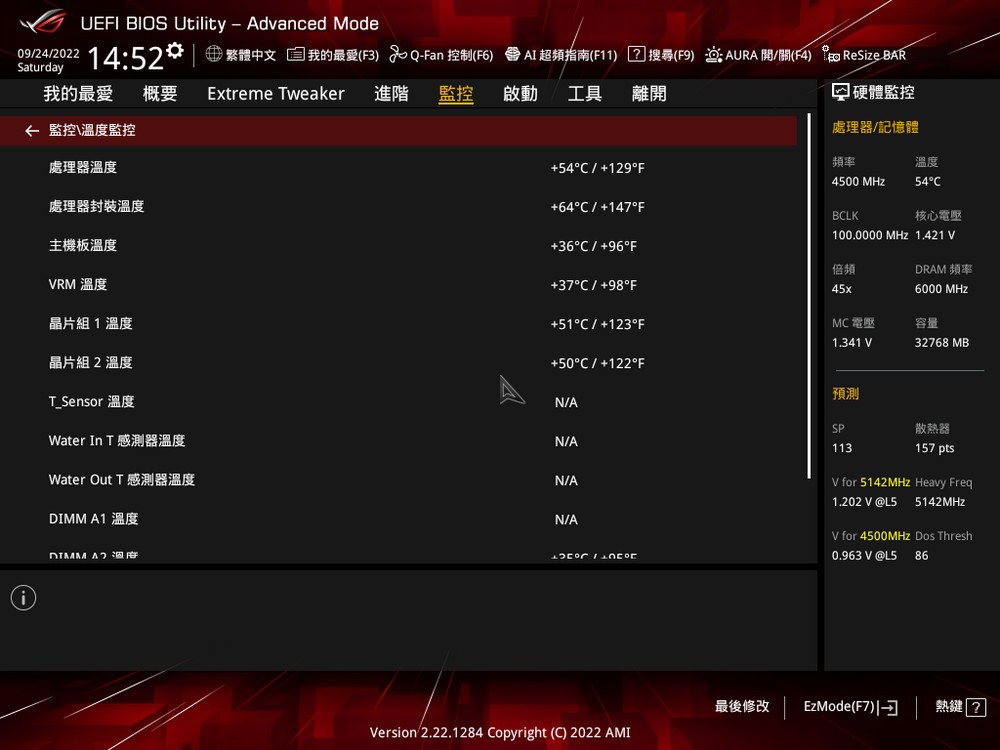
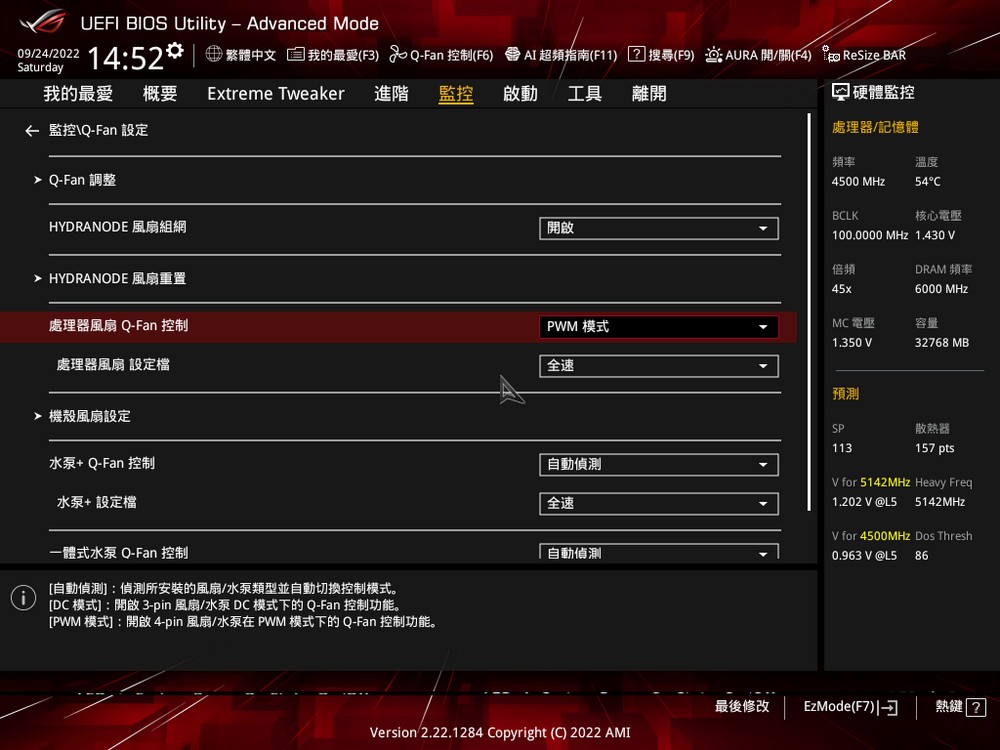
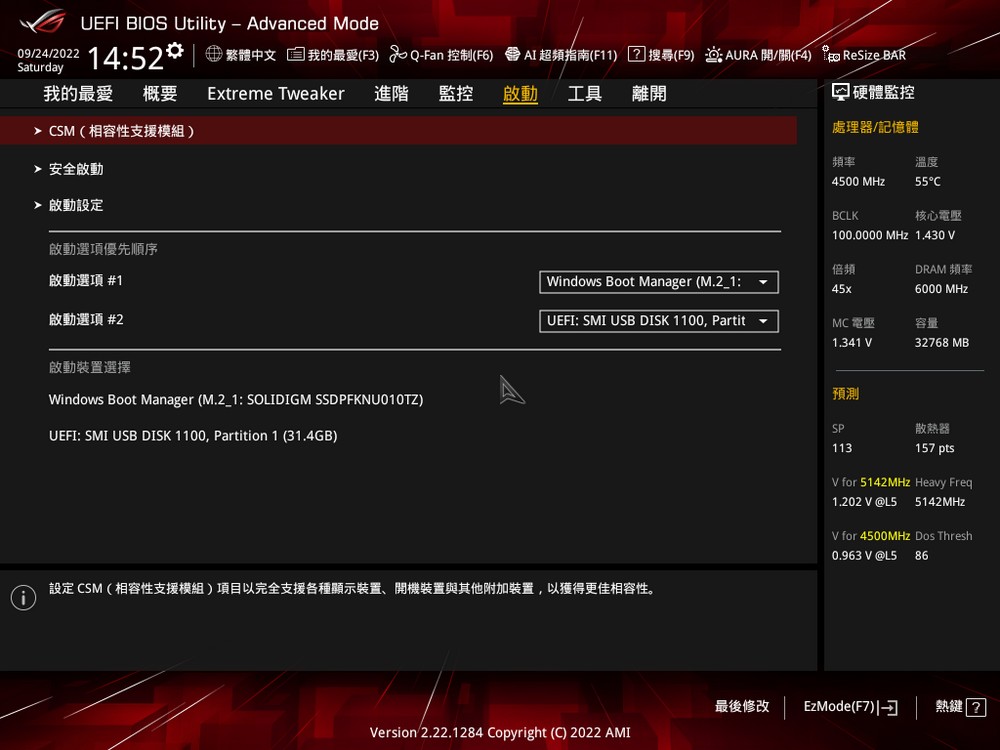
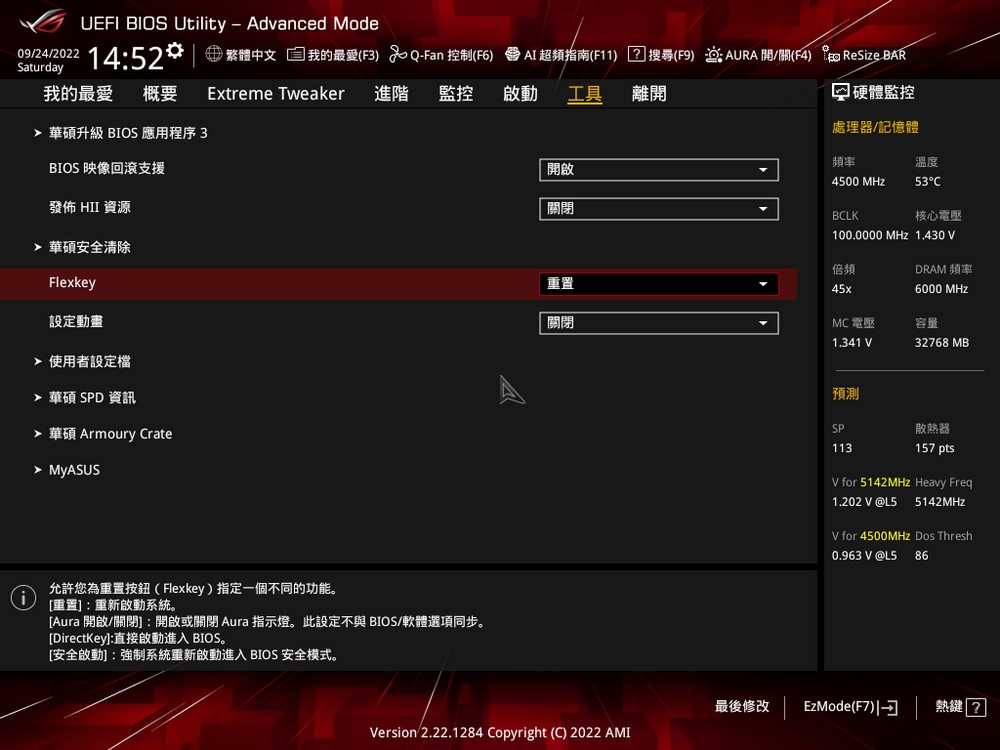
ROG Armoury Crate Unified Software / AURY Sync, FAN Xpert, Game first VI
The lighting effects of the ROG CROSSHAIR X670E HERO motherboard are mainly the dot-matrix Polymo lighting effects on the I/O shell. Players can adjust the lighting effects of the Polymo bitmap through the Armoury Crate software, and synchronize the graphics card and gaming with the AURA Sync device. peripheral functions.
The two main graphics, one is the main ROG font, and the other is the ROG logo and the word HERO arranged with the four English letters of HERO.
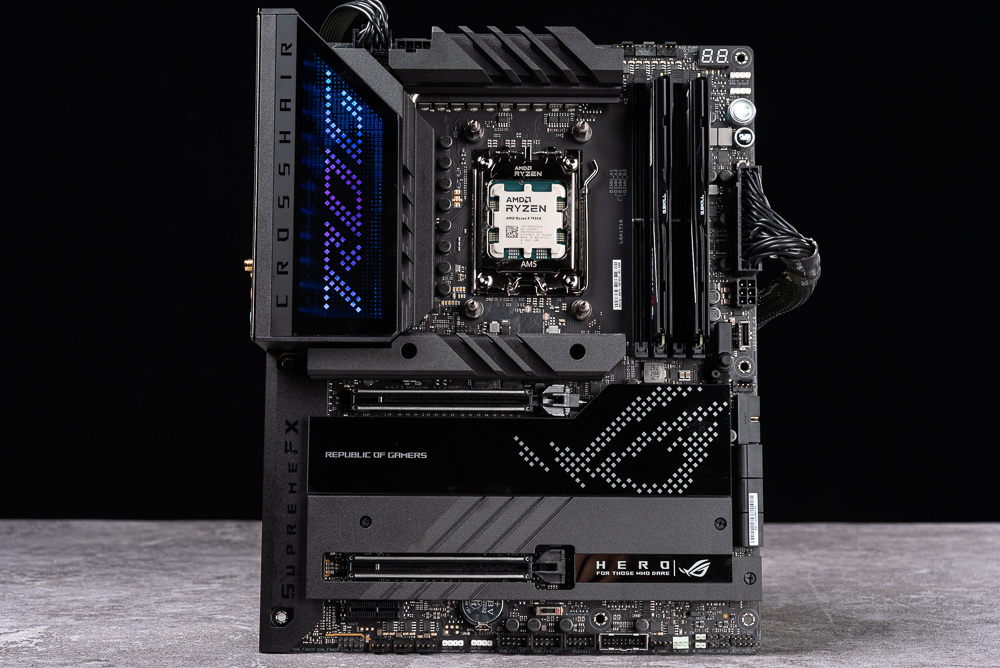
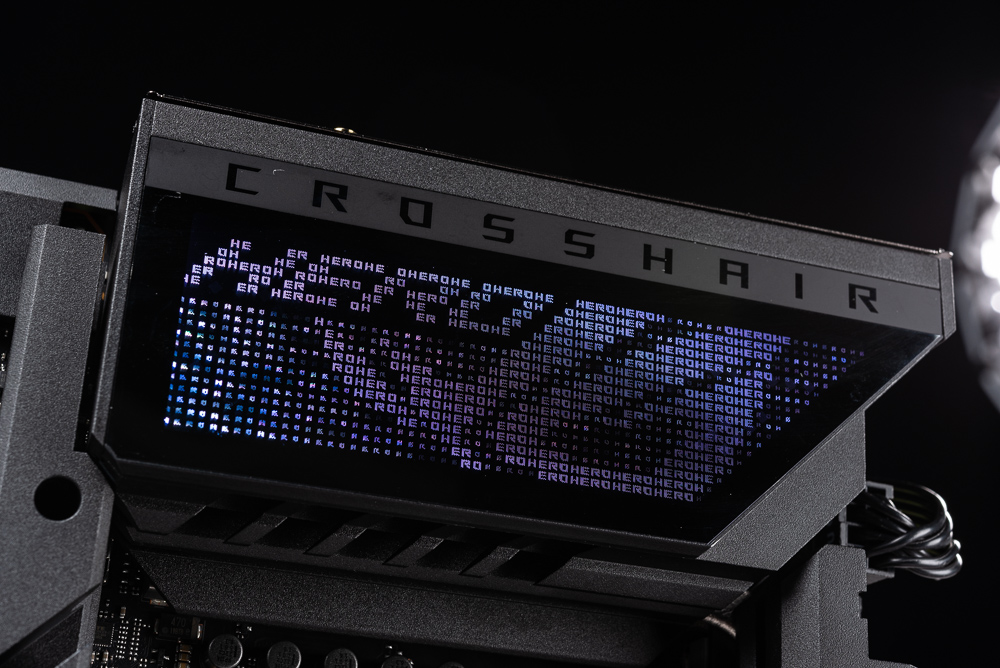
The new version of ROG Armoury Crate’s dashboard will display the basic information of the computer, as well as monitor the CPU clock, voltage, temperature, and other functions. If the motherboard AI Cooling is enabled, it will provide silent, standard, Turbo, and full-speed fan control functions, and The AURA Sync lighting effect of the host can be adjusted.
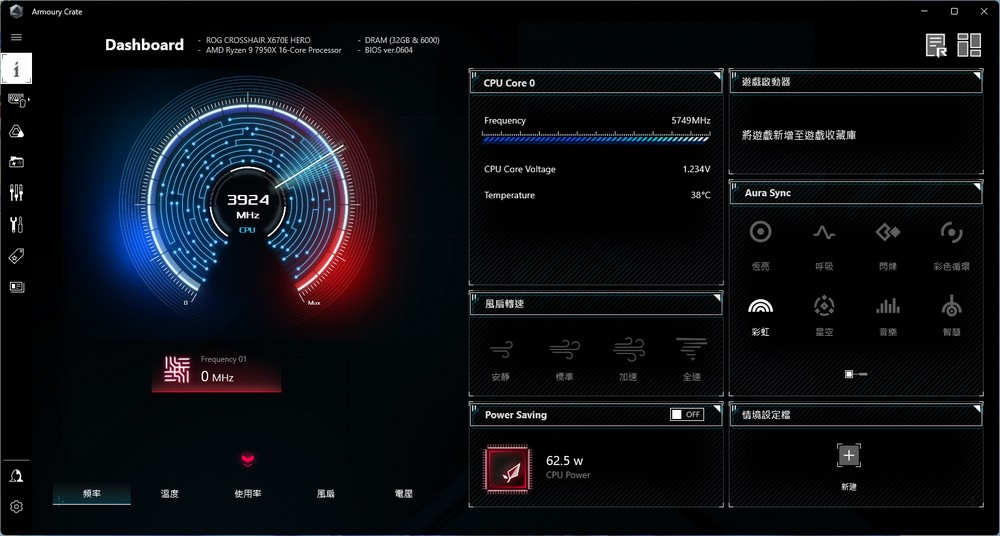
For ROG CROSSHAIR X670E HERO device settings, you can set the lighting effect at shutdown, ARGB settings, sound effects, disk information and independent Polymo lighting effect adjustment.
At the same time, the Armoury Crate device setting also supports Fan Xpert 4, and all the fan speed curves of the motherboard can be adjusted through software.

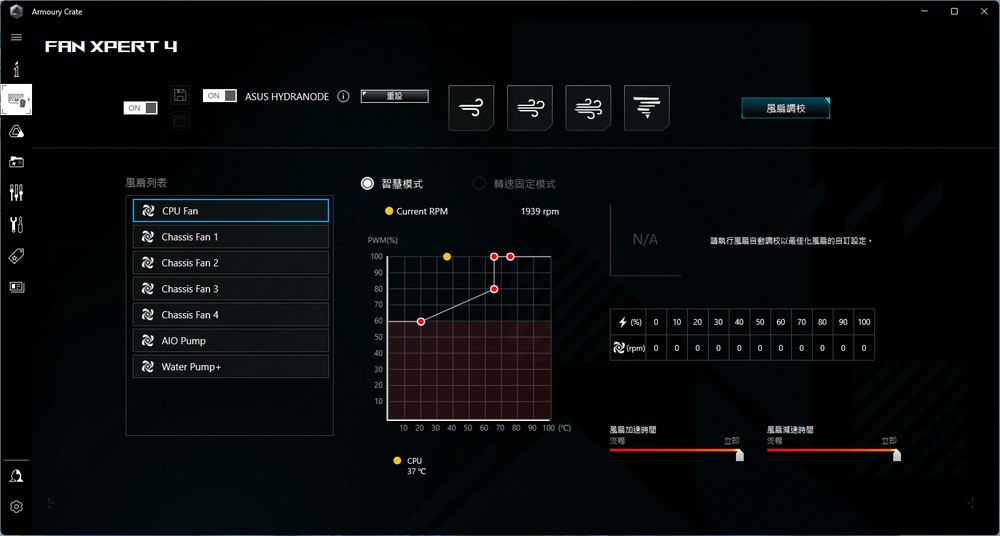
AURA Sync includes synchronization functions of various peripherals such as motherboard, ARGB external connection and graphics card.
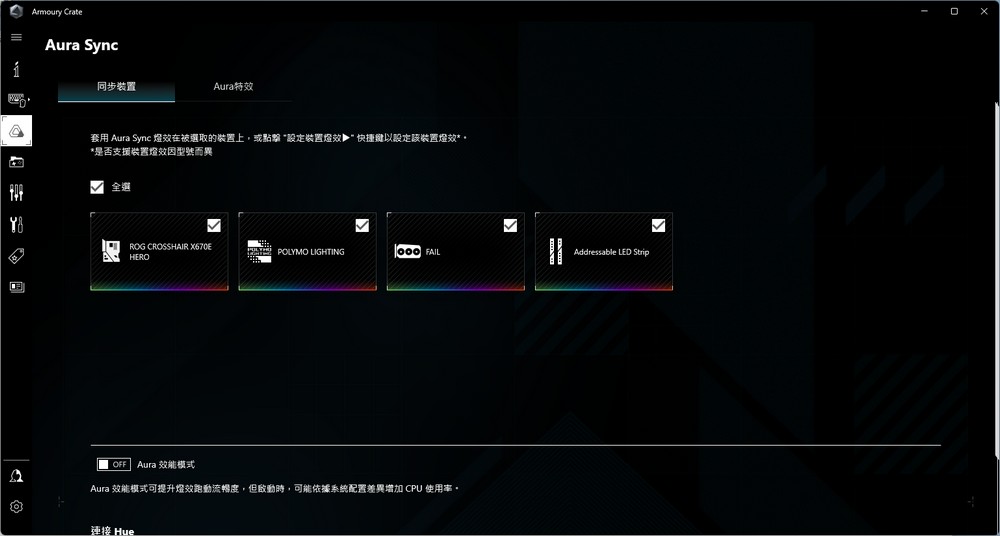
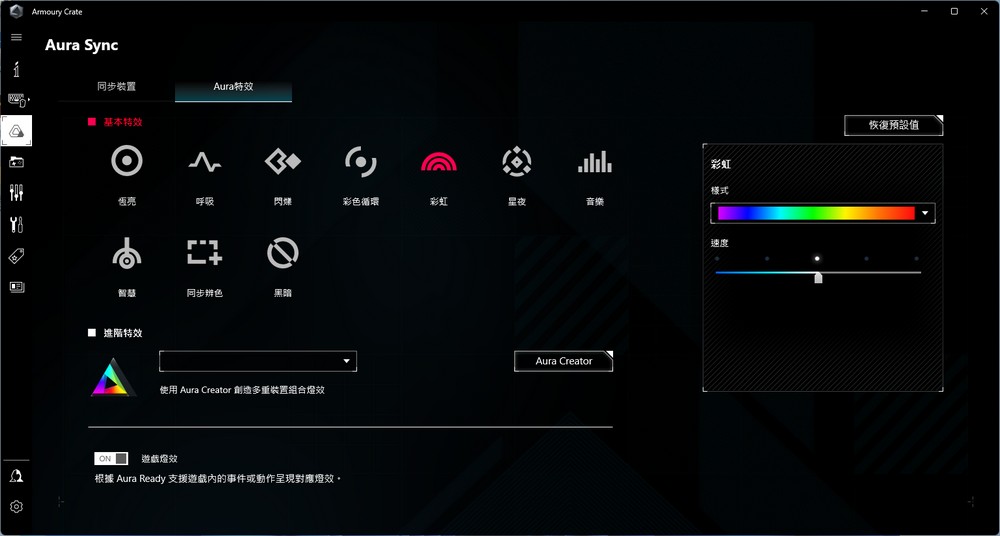
The game first VI provides an automatic network optimization function, with modes such as intelligent control, game priority, live broadcast priority, and video priority. The program will automatically identify the application and adjust the priority of the network connection. For example, games in game mode can get an extremely fast connection. Line priority; another function is to automatically assign applications to use different network connections, taking advantage of dual LAN + Wi-Fi.

ROG CROSSHAIR X670E HERO Motherboard Benchmarking / AI-Optimized Overclocking
In terms of performance testing, several common sets of CPU rendering, computer performance testing and game performance are used for testing. The processor uses AMD Ryzen 9 7950X, G.SKILL TRIDENT Z5 NEO DDR5-6000 16GBx2 and NVIDIA Geforce RTX 3080 Ti, the settings use the motherboard AI Optimized, PBO automatic function, the radiator uses ROG STRIX LC II 280mm AIO water cooling, the following The scores are provided for your reference.
Test Platform
Processor: AMD Ryzen 9 7950X
Motherboard: ASUS ROG CROSSHAIR X670E HERO 0604
Memory: G.SKILL TRIDENT Z5 NEO DDR5-6000 16GBx2
Graphics Card: NVIDIA GeForce RTX 3080 Ti
System Disk: Solidigm P41 Plus 1TB PCIe 4.0 SSD
Cooling Controller: ASUS ROG STRIX LC II 280mm
Power Supply: Seasonic PRIME PX-1000
Operating System: Windows 11 Pro 21H2
CPU-Z checked the information of AMD Ryzen 9 7950X processor, codenamed Raphael TSMC 5nm process 16 core 32 thread processor, with ROG CROSSHAIR X670E HERO motherboard test, BIOS has been updated to 0604, memory is dual channel DDR5 16GBx2 6000MHz .
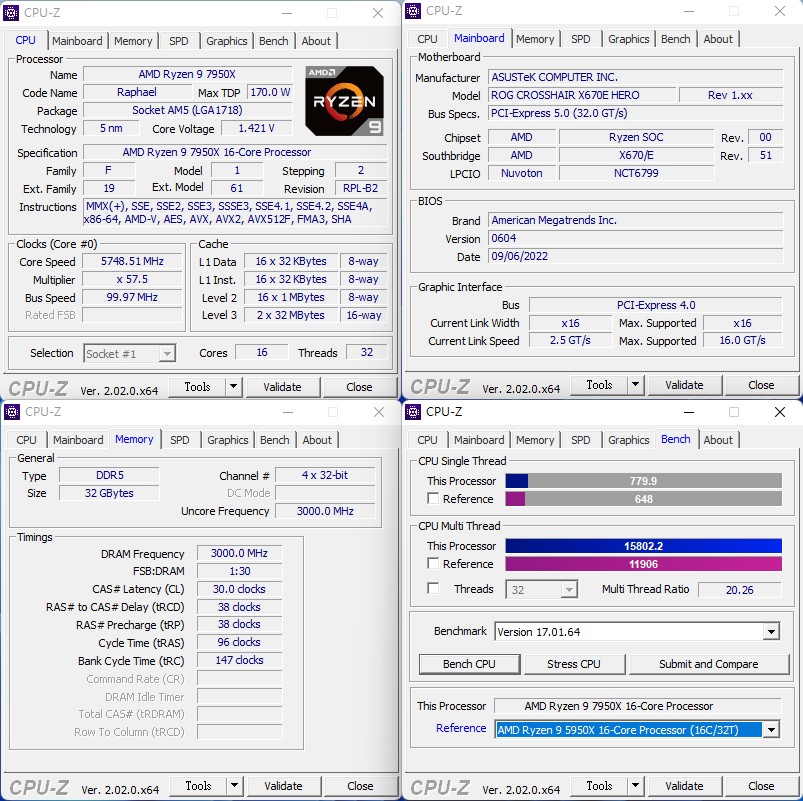
CINEBENCH R20 and R23 are developed by MAXON based on Cinema 4D and can be used to evaluate the 3D graphics performance of computer processors. It is also a common test software currently used to evaluate CPU computing performance.
The 7950X can achieve a CPU score of 15165 CB in the R20 version test, and the R23 version also has a CPU score of 38710 pts; the single-core performance has a performance of 797 pts and 2043 pts respectively.
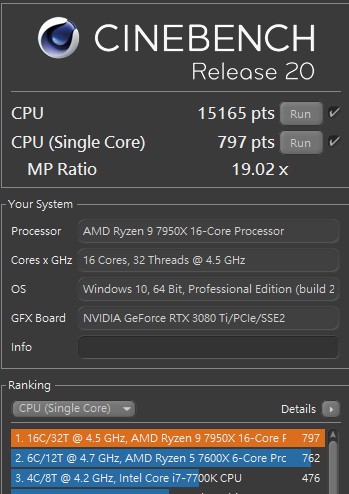
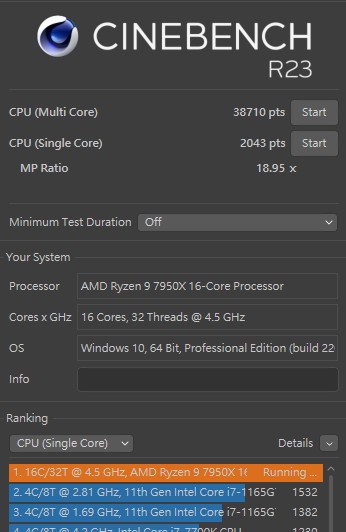
AIDA64 memory and cache test, the memory uses G.SKILL TRIDENT Z5 NEO DDR5-6000 16GBx2, with memory read 74211 MB/s, write 76667 MB/s, copy 69055 MB/s, latency 62.7 ns.
(AIDA64 has not officially optimized the Ryzen 7000 and X670E platforms, and the memory performance is only for reference)
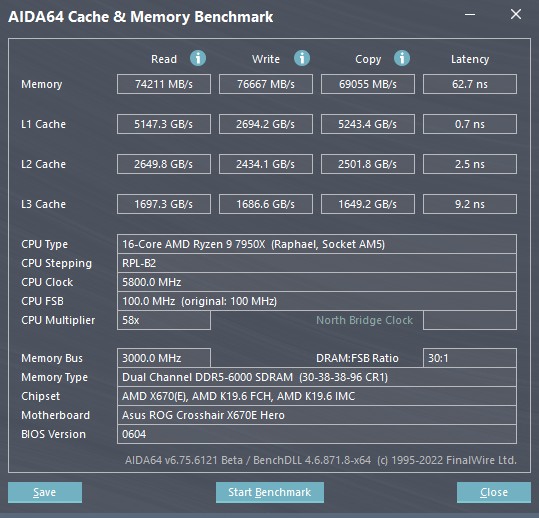
The overall computer performance test is conducted with PCMark 10, which can be used to score basic computer tasks such as App startup speed, video conferencing, and web browsing performance, while the Productivity test uses spreadsheets and paperwork as test items. As for Digital Content Creation, video content creation is based on photo/video editing and rendering, and visualization.
The 7950X and RTX 3080 Ti scored 10,169 points, the computer benchmark performance Essentials had 12,718 points, and productivity has 12,492 points. In the digital content creation that requires more CPU operations, it achieved a high score of 17,964 points; the recorded data shows that the CPU clock is the highest during the test. up to 5.8GHz.
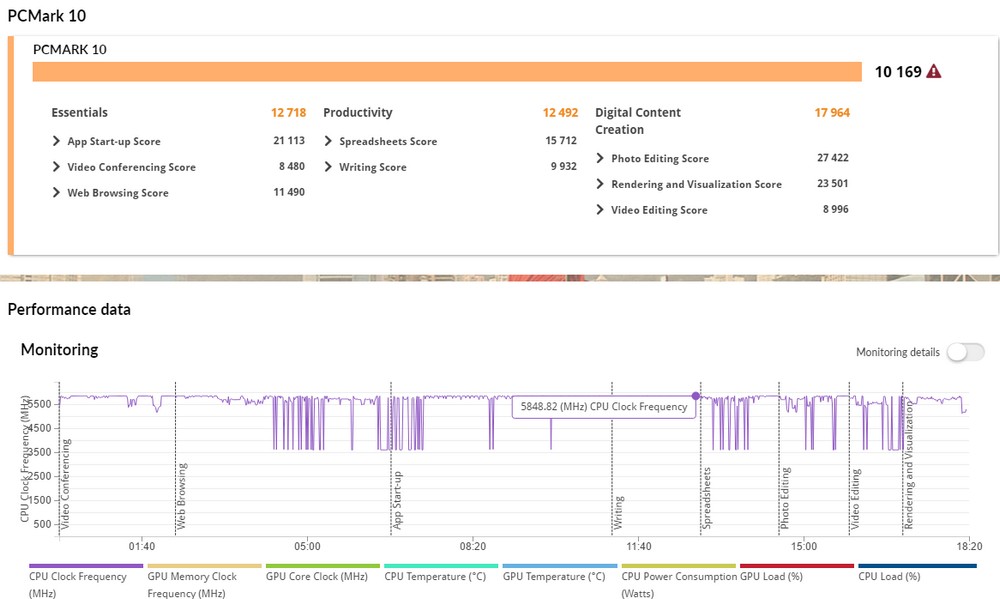
3DMark CPU Profile is a test designed for the processor. It mainly tests the physical operation and custom simulation of the CPU, and tests the performance of the processor at 1, 2, 4, 8, 16 and the maximum thread. So there will be different thread tests, because the number of threads used by different applications and games is different.
For example, the Max threads test can show the maximum performance of the CPU, but this does not mean that the game can also play the same performance, but only movie-level rendering, simulation or scientific analysis applications will use the performance of full threads; in the same way 16 threads also has a good performance for computing and digital content creation, and has little impact on games.
The i9-12900K Max threads can reach a score of 12405, which meets the needs of film-level rendering, simulation or scientific analysis applications, while the main game is 8 threads 8197 points and 4 threads 4384 points.
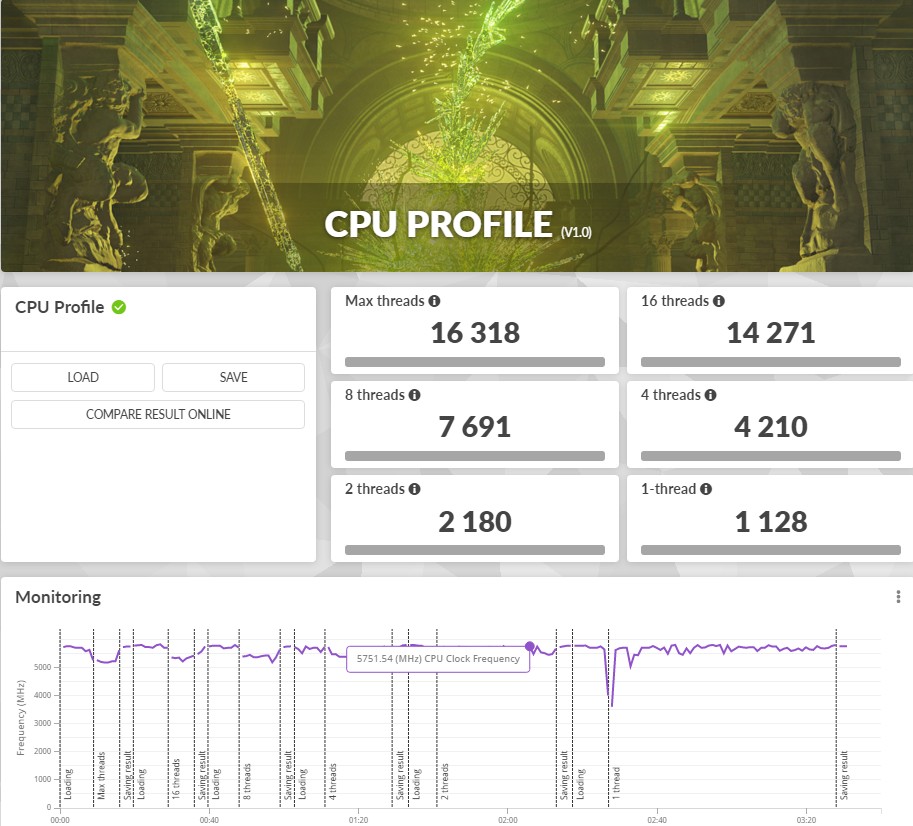
The 3DMark Fire Strike test uses the RTX 3080 Ti graphics card, and its CPU Physical Physics score has 46562 points; the Time Spy test designed for DirectX 12, the CPU scored 16994 points.
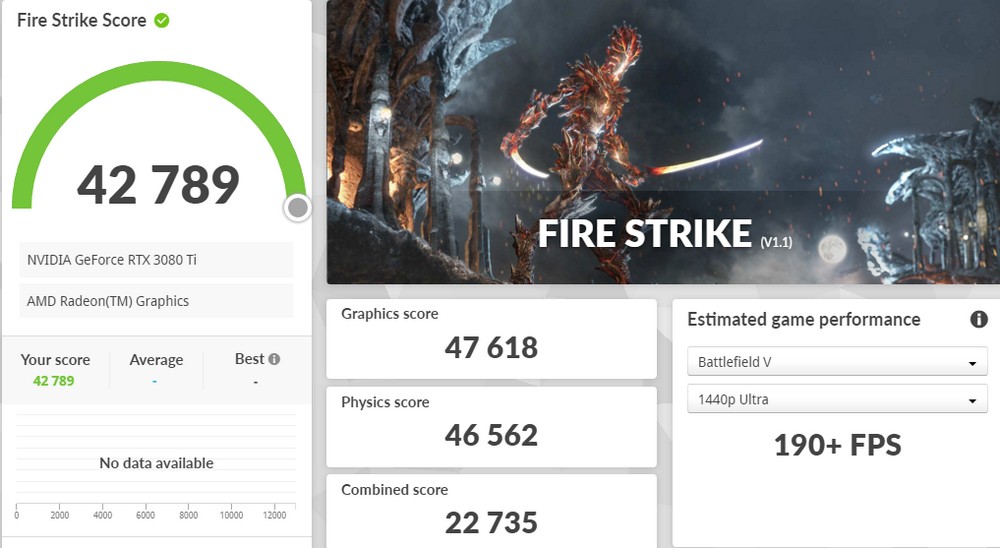
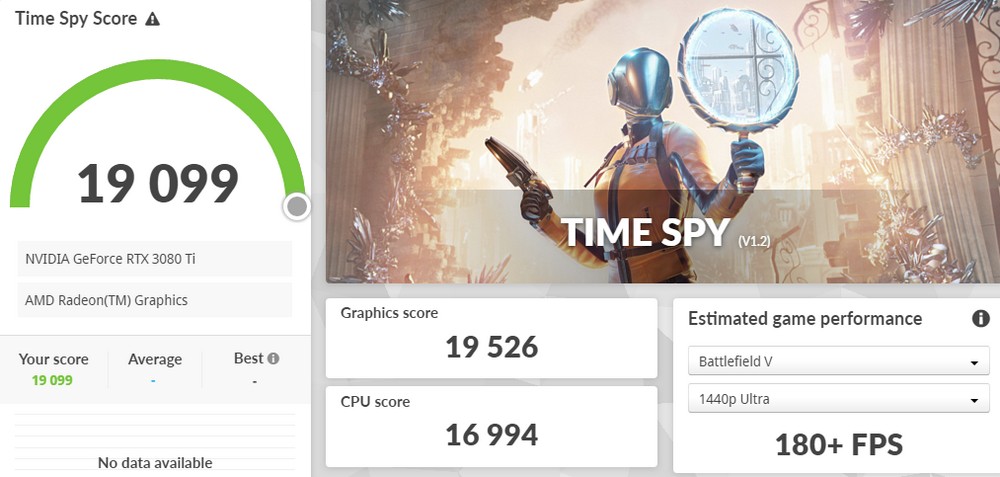
ROG CROSSHAIR X670E HERO USB4, USB 3.2 Gen 2×2, USB PD Test
The front USB 3.2 Gen 2×2 Type C provided by the X670E HERO, in addition to the USB 20Gbps transmission capability, also adds a 60W PD/QC4+ fast charging function. The test uses the USB Type E to Type C cable used in the general case, and conducts the charging test for the laptop.
The test can reach charging speeds of 19V, 2.49A, and 48W. As long as the I/O cables in the front of the case have support, they can quickly charge mobile phones, laptops and other devices.
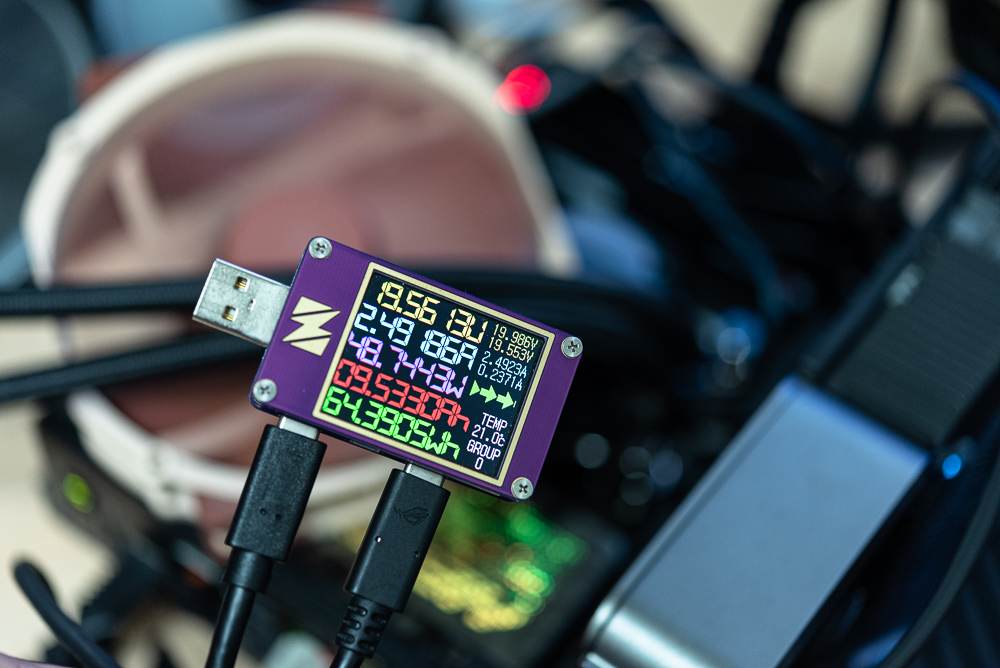
If connected to a USB 3.2 Gen 2×2 SSD external box, it can also achieve sequential read and write transmission performance of 1484 MB/s and 2085 MB/s, which is in line with the USB 20Gbps transmission capacity.
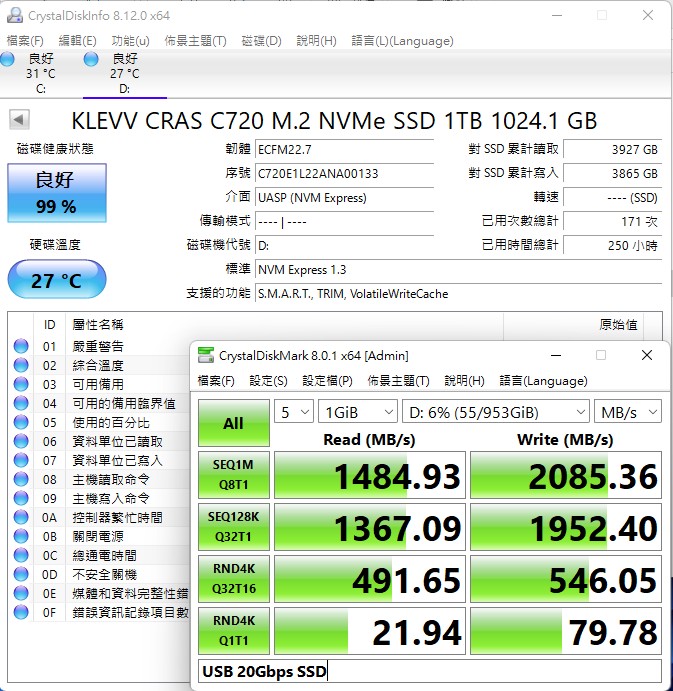
The 2 USB4 ports provided by the rear I/O of the motherboard are based on the transmission specifications of Thunderbolt, so they are also compatible with existing Thunderbolt devices (but not certified by Intel Thunderbolt).
Tested using a Thunderbolt 3 SSD HP P800, sequential read is 2865 MB/s, a Thunderbolt-compliant data transfer speed. (The P800 is only 500GB so write performance is quite low.)
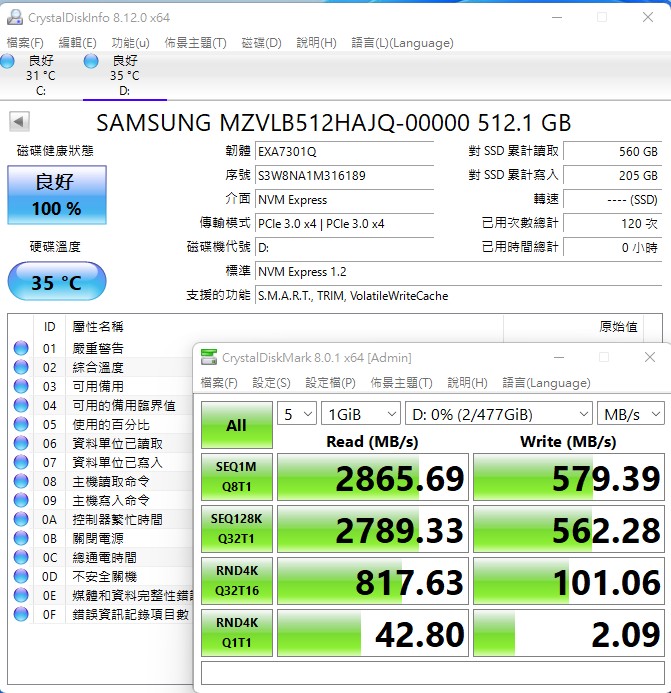
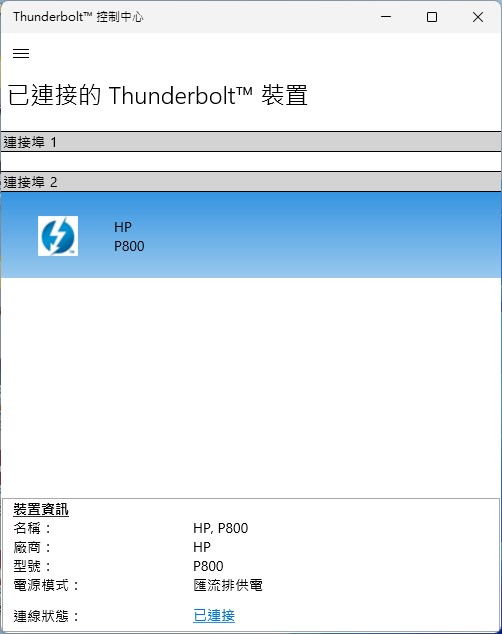
Summarize
ROG CROSSHAIR X670E HERO can meet AMD Ryzen 9 7950X 16C32T’s full-core 5.0GHz, single-core 5.7GHz Boost clock, and provide stable output with powerful power supply and VRM radiator, and also supports EXPO / XMP / AEMP of DDR5 memory, etc. Overclocking parameter settings, AI-optimized overclocking, processor SP prediction, and radiator performance rating have been added in this generation so that players who are overclocking for the first time can adjust the settings according to the motherboard recommendations.
In terms of specifications, the X670E HERO provides dual PCIe 5.0 x16 slots, dual M.2 PCIe 5.0 x4 SSD expansion capabilities, a total of 6 SATA, 4 onboard M.2 and 1 PCIe 5.0 M.2 Card storage expansion, and network The road is 2.5GbE + Wi-Fi 6E, and it also provides high-speed ports such as USB 3.2 Gen 2×2 Type C, front fast charging 60W PD/QC4+, and 2 USB4. This specification is quite enough for all players.
The specifications of these generations of HERO are not inferior to EXTREME too much, but the relative price of ROG CROSSHAIR X670E HERO may be more than 15,000 and similar to Z690 HERO, but the good thing about AMD is that AM5 will be used at least in 2025, this board is definitely worth it Invest in a high-end flagship, and even if you upgrade Ryzen in the future, you can upgrade directly and painlessly (without changing the board).
If this article is helpful for you, please share this article with your friends on social media. Thank you!!
This article is based on the personality of the reviews. You are responsible for fact-checking if the contents are not facts or accurate.
Title: AI overclocking! ROG CROSSHAIR X670E HERO unboxing / full specifications, I want all of them without dividing the channel